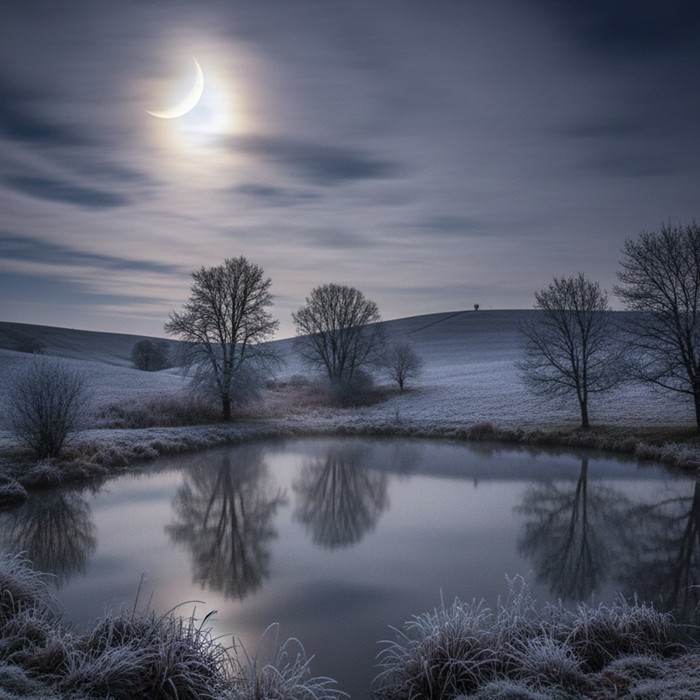
432 AND ABOVE EME NEWS
November 2025
Volume 54 Number 11
Editor: Peter Blair G3LTF & Barry VE4MA
Production Assistance: Frank NC1I & Bob W1QA
News, Contests and Dx-peditions
The final section of the 2025 ARRL EME contest is over. So far 205 logs have been received (249 last year). Again 23 cm was very busy and 70 cm less so. This contest will be remembered for the advent, and impact, of the 1.5 m solar cooker dishes on 23 cm with several being operated from temporary locations, like a patio. Gene, KB7Q made 85 QSOs and Dave KG0D made 52 with their “cookers”. At the other end of the antenna scale Zdenek, OK1DFC made 189 x 142 QSOs on 23 cm and 61 x 53 on 70 cm. Jay, N1AV made 130 x 114 on 23 cm and 66 x 60 on 70 cm. (Jay is likely to lead overall as he has big scores on 144 MHz to add in as well.)
Mila, OK1VUM made 105 x 89 QSOs on 70 cm. In the multiple operator stations on 23 cm K0PRT leads with 174 x 134 with W2ZQ working 165 x 139. On CW Peter, G3LTF made 62 x 54 QSOs on 23 cm and 9 x 9 on 70 cm. Read more details in the individual reports below, especially Jay’s heroic battles with the weather with one arm in a sling!
Bob KA1GT ran a survey to gather reactions to this year’s ARRL EME contest and the results can be seen here. Thank you for organising this Bob.
https://bobatkins.com/radio/EME_survey_1.html
Only 18% of the 146 survey participants found the log submission process easy and in response Bart, W9JJ, the ARRL Radiosport and Regulatory Information Manager, posted on Moon-net a clarification of the submission process which is reproduced below at the end of the reports.
There is still time to get your entry in, the deadline is December 9th.
Earlier in the year there was concern over the detail of the contest exchange specified by the ARRL and Bart clarified the position on this as well, as follows:
“The recommendation regarding exchanges has been an area of unintended confusion, as we (ARRL Contest Program) did not well describe the intent or expectations of the on-air exchanges, and I will be sure it is clear for 2026.
In summary, we want each station to exchange AS USUAL and CUSTOMARY your signal reports and any other information to confirm a completed QSO. Those exchanges could be basic O, RO, RR, M, T, etc. They can also be RST, or signal levels R+##, R-##, etc. This is information you record in your logging records.”
This is a welcome clarification and hopefully will be in the rules for 2026.
5 bands EME in 40 minutes!
Another EME “First” was established this month. OH3LWP and OE5VRL made contact via EME on 5 bands in 40 minutes. 3, 6, 9,13 and 23 cm. See their reports for more detail. Congratulations Ari and Rudi!
Articles and Announcements
Don't miss the articles and announcements that follow this month's station reports.
8Q7UM
Alex EA8DBM, operated from the Maldive Islands from November 3rd to 9th giving a new DXCC to many;. 163 QSOs, 5 on CW and 60 in the contest period. See his report below. Another great effort deserving thanks from us all.
Contests
The DUBUS-REF CW-SSB contest series starts on January 31st with 432 MHz. The dates are listed at the end of this Newsletter and will be incorporated in the DL7APV calendar https://eme.radio/dl7apv-eme-calendar
In response to feedback there are two changes from the 2025 series:
All contests are on Saturday, but the 23 cm one is two days, Saturday and Sunday
24 GHz has been separated from the 10 GHz weekend
Rules will be posted shortly on http://www.marsport.org.uk/dubus/eme.htm
Dx-peditions
Don’t forget the 13 cm Activity Weekend proposed by Jan, PA0PLY on December 6th and 7th, 2025. The moon-passes have good windows to the east as well as to the west. Get the gear tuned up ready for the DUBUS-REF contest on February 28th.
Alex EA8DBM informs me that at the end of January and early February, he is planning to visit Peru and the Dominican Republic. Watch the usual places for more information.
DL7APV EME Calendar https://eme.radio/dl7apv-eme-calendar
The 2026 version is now ready, if you have events planned that should go in there please let Zdenek know about them:
EME conference 2026
May 28th-31st Tenerife, Canary Islands.
Only 6 months to go! See the latest update on booking.
8Q7UM Alex
For the second leg of the ARRL EME, I decided to go to the Maldives. There hasn’t been much activity from there for many years. The climate is great — warm and pleasant, unlike the European November.
Station activity was excellent in my opinion, and the results exceeded my expectations: 163 QSOs on 23 cm, including several CW contacts.
If anyone’s interested, there’s more information and the full log on my blog: https://ea8dbm.substack.com/p/8q7um-from-mj63sl-maldives-is
You should definitely read the blog, Murphy always visits him but, 7,000 km from base, and sleep deprived, he always manages to fix it. Salute! Ed
 8Q7UM dish
8Q7UM dish
DC1RDB Robert
With my two yagi 70 cm station, I was QRV for only a few hours on Saturday and Sunday of the contest window in November, but nevertheless was quite happy with the results. I made a total of 19 contacts, six of them were initials for me: OK1DFC, W3TI, S56P, OH3AWW, OH1LRY and KN0WS.
In the week after the contest, I managed to complete a few more initials on 23 cm: NC1I, OK1VUM, SP5GDM, DF3RU.
I could not use my new 23 cm solar cooker station during the EME contest weekend in November because the portable setup is not weatherproof and it was raining throughout the weekend. Despite the limited sky view window of my portable 23 cm setup on the patio, I am very satisfied with the performance so far.
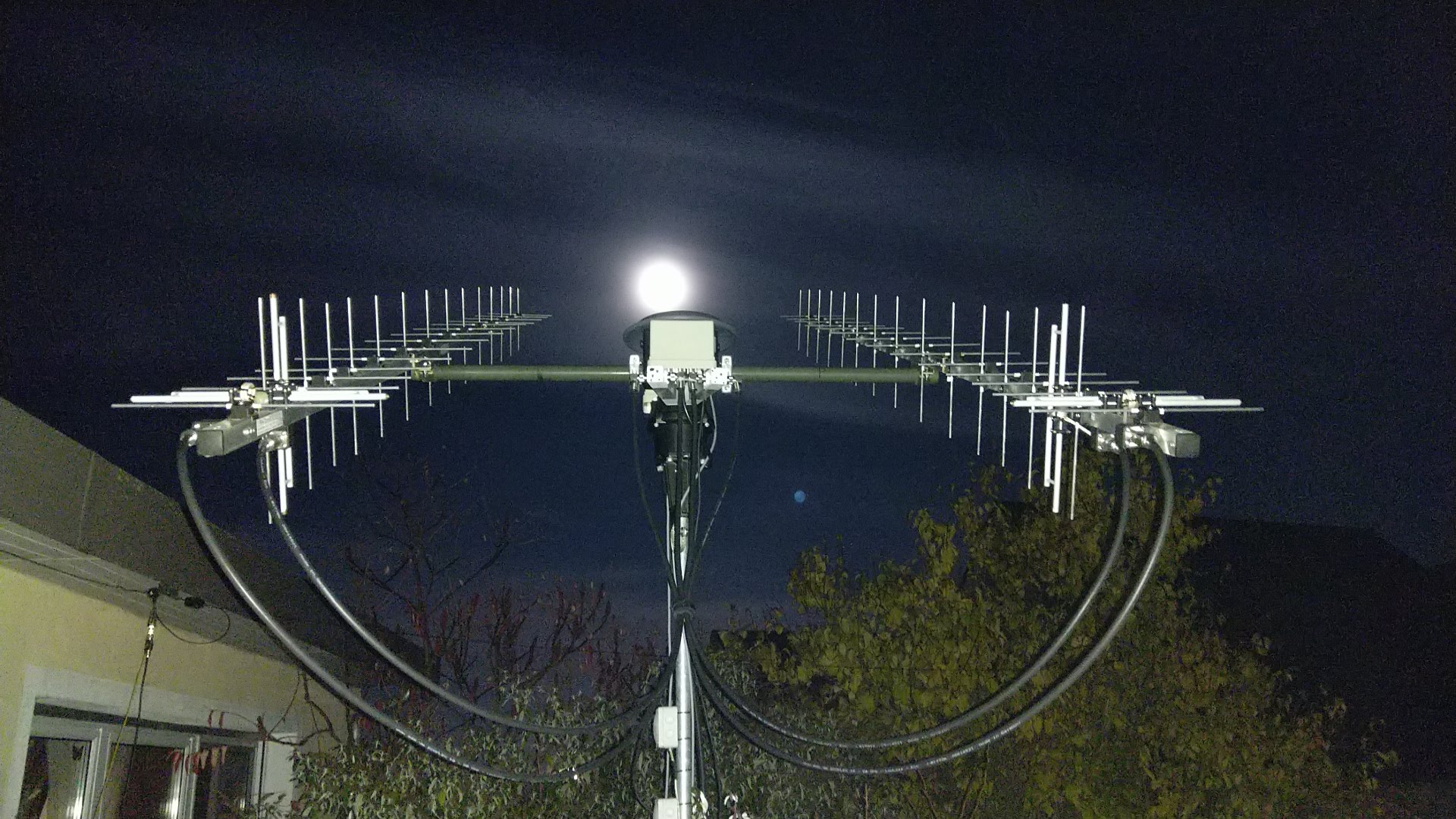 DC1RDB 70 cm antennas
DC1RDB 70 cm antennas
DL1VPL Thomas
I heard and tested with XQ3SA (hrd -24 !), but no QSO so far. I hope for the next moonpass!
November 3 I QSO'd with BG2AQX (4x17 / 250 W) -27/-22, my 1st QSO with China!
November 4 BI1QGX heard me with a good report, I have to wait for his TX upgrade.
There is good future activity from China on 70 cm EME, as some more stations were in the HB9Q chat.
During the ARRL contest: I made on 70 cm 64 QSOs. Activity was quite good, but we had several times of cross polarity conditions to NA, so I missed some stations. Interesting contest QSOs were made with OK1TEH (1 yagi / 800 W - good reports both), VE3CIQ (3 m Dish / 200 W), IZ3ATX (2x19 / 800W, JN55) and GM0ICF (4x9 / 400 W).
At the finish I had 2 CW-QSOs with DL9KR and G3LTF.
Thanks for all the QSOs I still have only 4x13 el. antenna on 70 cm.
G0JDL John
After a relatively quiet few months during the summer 70 cm EME finally seems to have come back to life for me. During November I worked OM3TRN, OM4EX, S57Q, DL5BBH, PA2CHR, OH1LRY, OH3KLJ and OZ7UV for initials on the band as well having QSOs with ON7EQ, OK1VUM, JO4KVP, GW4ZHI, OK1DFC, SP2WRH, NC1I and DL1VPL. This gives me 56 initials for my first year of EME operation on 70 cm
The QSO with Jan, DL9KR was a rather special one for me as it was my first CW QSO via the moon. When Jan suggested we try I had no idea about CW on EME so I had to learn quickly and was actually reading CW EME procedures as the QSO progressed but eventually we managed to exchange callsigns, OOO, RO and 73. Jan’s station did all the hard work as I only have 2x14 and 200 W at the feed point. This QSO really made my day.
After having somehow managed to damage an SP70 LNA beyond economic repair (I suspect the rated power is a bit optimistic) I decided to change to an Antennas-Amplifiers EME2-432 LNA and Advanced Sequencer. I didn’t receive these in time for the contest and have only had a few days in which to compare the EME2-432 with the SP70 but my first impression is that the new LNA gives me a lower background noise (both LNA’s are supposed to have the same gain) and the few birdies I have on the 70 cm band (all at low elevation) are much reduced in number and in strength.
I finally got round to using OZ9AAR’s SkyScanner app to look at the noise levels at my QTH. I have limited moon visibility, about 060° to 270° at elevations above 15° but with the exception of a small area of high noise, when the antennas are almost pointing at my house, the results are reasonably good.
The EME2-432 LNA apparently has a BPF internally, and in spite of my location being rural and away from Cellular sites... it may be better.
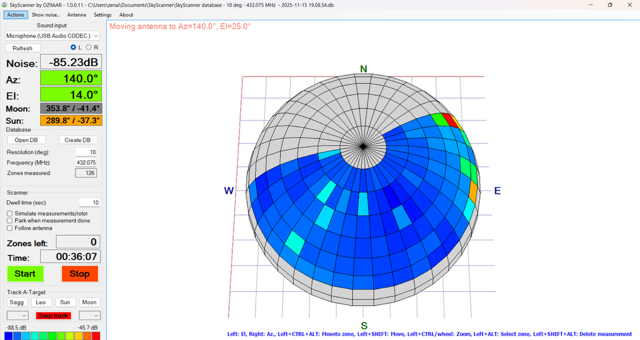 G0JDL Sky Noise Map
G0JDL Sky Noise Map
G3LTF Peter
On the 6th of November on 1296 MHz I worked Alex 8Q7UM on CW #569 and DXCC #88, DJ3JJ, LA3EQ and G4CCH. On the 8th I worked DL1HUH #570, NQ7B, DF3RU, ES3RF, W2ZQ, DL3EBJ, DL3EBJ, KN0WS, DK3EE, VE6BGT, IK2DDR, DL4DTU, K3SK #571, LA3EQ, IQ2DB, SP9VFD, PI9RD, DL7UDA, UA3PTW, PA7JB, SP7EXY, WB8HRW, W2ZQ, G0LBK, K0PRT. I copied SP0KKD 549 but they could not copy me. After extracting the duplicates I added 16 to make a total of 62 QSOs.
I decided to put the 432 MHz feed in for the final pass and worked DL9KR, PC0A #490, PA3DZL, DL1VPL, OK1VUM, S5ZQ #491, OK1N #492, UA3PTW and G4RGK. I hadn’t been on 432 MHz for some time but was pleased to find that the local noise level doesn’t seem to have increased much, if at all. I can’t see the sun now until early March but I checked Taurus and saw 1.1 dB vs cold sky which is close to previous measurements.
Overall ARRL contest score on 4 bands, all CW, 70, 23, 13 and 6 cm was 9 x 9, 62 x 58, 20 x 19 and 12 x 12 = 103 scoring QSOs, 90 multipliers, giving 927,000. 80% of the QSOs were with Europe, 16% N. America and 3% Asia.
I plan to be on 13 cm for the activity weekend Dec 6/7th with 6 m and 250 W at the feed.
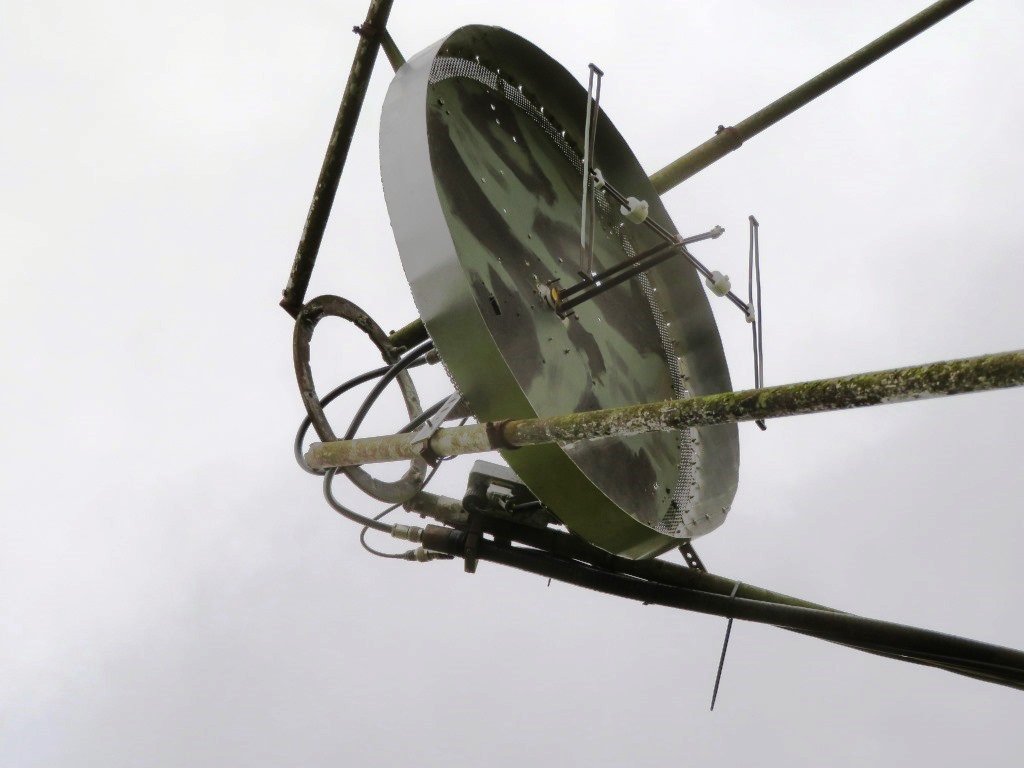 G3LTF 432 feed in dish
G3LTF 432 feed in dish
G3YEG Nic
For all of this months QSO's and reports I was using all 21 elements of my 25 year old Tonna antenna in my attic as, at low moon elevation, it will just fit in.
Following last months one way comms with Dmitrij UA3PTW, on 6th November I managed my first qso with Dmitrij at -17 dB / -26 dB - I did have a couple of retry's of my RRR message to Dmitrij. The takes my grand total of initials to 4 since my first QSO with Bernd DL7APV just over 4 years ago. The 2nd leg of the ARRL contest was not a great success as my best antenna position was during the wee small hours of the night which would not have been appreciated by my XYL. However I did manage 3 new decodes - SP2WRH at -27 dB and S56P with best of -25 dB and S57M with best of -24 dB. This takes my grand total of decoded stations up to 44. Later in the month I managed a couple of QSOs with Frank NC1I when degradation was more than 2.1 dB at -20 dB / -28 dB (very wet roof tiles) and the next day best -18 dB / -29 dB (very wet roof tiles + thick fog). Later on Frank's signal quickly degraded by 4 dB when a very heavy rain shower soaked everything again.
G4BRK Neil
I dabbled in the ARRL EME contest second weekend (8-9 November) on 23 cm using my tropo system, with 300 W / 36 el but with no elevation. I can get signals until the moon is up about 7 degrees or so. My preamp is in the shack and there is quite a bit of noisy foliage in the yagi pattern at moonrise, which means I am quite deaf compared to stations with dishes or elevation.
I tried calling CQ using Q65-30B and was spotted on LiveCQ by RD4D. I couldn’t decode him at first despite his higher power but after a while I started getting decodes and managed to make a QSO. I also worked K0PRT, OK2DL (needed Q65-60C for this QSO), OK1DFC and DL0SHF, which was quite pleasing given my setup. RD4D and DL0SHF were new initials.
G4CCH Howard
My 5.4 m dish (0.5 f/D) was 25 years old in June this year, and my W2IMU feed was 42 years old this month. The dish still appears to be OK, but the feed has lost a bit of performance over the years and I need to replace it soon. I would like to change to an N2UO in 2026, but I have to either make one myself, or find someone who can.
Digital contacts identified with (D)
1st November - F5AOL (D) digi Initial #702
4th November - 8Q7UM (D) digi Initial #703, DL3EBJ, IK2DDR, N4BAA (D) digi Initial #704 and W3TI (D)
6th November - VK3VJP (D), 8Q7UM CW Initial #584 and CW DXCC #89, JA4UMN (D), ON4BCB (D) digi Initial #705, SO5AZ (D) and G3LTF
ARRL EME Contest
I added 34 CW contacts to my contest score making my score 62 x 52.
On the 8th of November: DL3EBJ, OE9ERC, KN0WS, W2ZQ, N1AV, JH5LUZ with slow deep QSB, PI9RD, ES3RF, DF3RU, PA3DZL, DL0SHF (D) digi Initial #706, IK1FJ, IQ2DB, SP0KKM CW Initial #585, RA2FGG, SP7EXY, I2FAK, DL4DTU and PA7JB
On the 9th of November: G0LBK, VE6BGT, IK3COJ, OK1DFC, K8ZR, WB8HRW DUP, DL7UDA, K0PRT, VE4SA, W3SZ, W4UNU (D) digi Initial #707, WA3RGQ, JJ3JHP, W3TI, KG0D, BY1BY (D) digi Initial #708, OK2DL, VK5MC, SP9VFD, F5JWF, PA3FXB, SP3XBO and SV3AAF
On 11th of November - DJ3JJ (D) digi Initial #709 and LX/ON4MU (D) digi Initial #710 and digi DXCC #140
On 16th of November - F1PDX (D) digi Initial #711, ON4BCB, DJ3JJ, N4BAA (D) and N4BAA CW Initial #586
G4RFR - Julian G3YGF
We are still working on improving the alignment of the 4 petals of the dish to get the gain up and testing the RW1127 TWT for 24 GHz.
GW4ZHI Bryn
I have been mainly concentrating on 23 cm over the last few weeks and getting to know the characteristics of the 2,4 m dish and in particular which directions are feasible and at what moon elevation. Anything below about 20 degrees in the direction of moonrise is tricky but after that I have a good view of the moon until near the moonset.
Last month I was very pleased to work PY0FBS. Unfortunately Alex HL2/LY3UM got away. However, I was very pleased to work him as 8Q7UM this month.
I was away for much of the ARRL competition but on the 9th November was able to work SP3YDE #, RD4D, ES3RF, YO2LAM, OZ5TG, DL1SUZ #, OK1USW, JJ3JHP and LA3PNA #. Initials on 23 cm since starting operation in August are now up to 88 - hopefully 100 by Christmas.
I am taking delivery of a 500 W BEKO PA shortly together with some LDF 5-50. This will allow me to keep the PA in the shack and produce about 300 W at the feed without over-stretching the PA. With winter approaching I am very glad not to have to keep the PA outside as is the case at present.
Although I still like to keep a paper logbook, I have adopted CloudLog as my electronic logging program because it is cloud based and will of course run on any platform. In particular it makes uploading QSOs to LOTW very simple which is a great advantage as GW is of course in demand as a DXCC and confirmation of QSOs, both paper and LOTW, are being requested frequently.
I2FAK Franco
I was active on 23 cm, but not for the full moon pass of the second leg of the ARRL contest in DG and CW modes.
My final result: 126 total QSOs, with 19 in CW a grids total of 108 and a score of 1,360,800
I had many new initials:
8Q7UM (DXCC # 58), F5AOL, DK3SE, SP6JLW (cw), SP9VFD (cw), W4ATC, K0DSP, AG6EE, WA6PY (cw), VE6BGT (cw), K1DS, W6TCP, N6NU, VE4SA,
JH5LUZ (cw), IK7UXW, LA3PNA, ON4BCV, DL7UDA, G4ALH, DL3WDG, LX/ON4MU (DXCC # 59, ini. # 266 )
Unfortunately not many stations were active on CW.
IK1FJI Valter
Before the contest I worked on 23 cm PI9RD 589/599, IK2DDR 579/589, DL3EBJ 589/589 , DJ3JJ 549/559.
In the second leg of the contest I was QRV on Saturday from 19:30 TO 23:30 Z only on CW and worked IK3MAC 589/589, PA3DZL 579/579, JH5LUZ 559/579, G4CCH 589/589, F6ETI 559/579, OK2DL 589/579, IQ2DB 569/579, SP9VFD 569/579, DF3RU 589/589, DL3EBJ 589/579, OM4XA 559/ 569, LZ2US 579/579, SP7EXY 569/569.
On the first contest weekend I had 14 QSOs, and in the second weekend also 14 QSOs for a total of 28 CW QSOs.
My station uses a 3.8 m dish with septum feed + flare, LNA 0.2 NF 35 db gain, and a TH327 with 1300 watts at the feed.
IQ2DB AVolta EME Team
This year we participated in the two sessions of the ARRL Contest only part time, as a single operator on a single band (1296 MHz).
The station was always operated remotely. We ended up with 146 valid QSOs with 118 multipliers and had 12 CW QSOs, but we only spent a little time in the lower part of the band. It is nice to see that most of the traffic is now finally in 30B mode (or even 15A). This makes the contest a bit more dynamic!
In 4 years of activity we have now reached 89 countries and 445 Initials.
https://alessandrovoltaemecomo.com
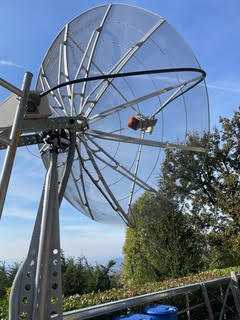 IQ2DB 3m Dish
IQ2DB 3m Dish
IQ2DB 3 m Dish, Septum Feed, XE1XA flare, G4DDK LNA
IZ0JNY Ivan
I’ve been essentially in stand-by for about 4–5 months, partly due to the unbearable summer heat and partly because of work on the tower that supports my dish. For this reason, I haven't sent many reports this year. At the end of September / beginning of October, I finally upgraded my dish, moving from the Gibertini SE100 (100 cm) to a Kathrein CAS-120 (120 cm).
It was a well-considered purchase, especially thanks to the continuous exchange of information and experience with my friend Miguel, CT1BYM, who has been using this dish with great satisfaction and achieves remarkable performance on all bands (10, 24, 47 and 76 GHz).
The first thing that stood out was the improvement in gain compared to the previous setup, based on measured Sun noise as shown below:

Of course, this improvement is not only due to the larger collecting area, but also to the superior shaping and accuracy of the reflector. I used the Gibertini 100SE with great satisfaction, making around one hundred 10 GHz EME QSOs and three 24 GHz EME QSOs. However, the CAS-120 is simply a higher-class product, and you can tell that just by handling it.
I then updated my 10 GHz EME setup, moving from a two-box configuration (one at the feed and one under the dish arm) to a single-plate layout. This setup provides 29 W at the feed thanks to a modification to the bias PCB, and combined with the dish upgrade, the performance is clearly on a different level. I have been able to work the following stations available on HB9Q logger during 2 days closest to perigee: OH3LWP (-14, -18); IK3GHY (-14, -15); IU3CQP (-15, -15); YO2LAM (-11, -20); IZ4BFA(-18, -19); IZ3VTH (-18, -17); ON5TA (-12, -14).
I even completed a Q65-60D QSO with the Moon near apogee with Gino, IK0HWJ (-10 / -17). This would have been unthinkable with the previous configuration (100 cm dish and 19 W at the feed).
Then, November 8th was for me the day of my greatest satisfaction. After a very easy 24 GHz EME QSO with Peter, OZ1LPR, I managed to work Mitsuo, JA8ERE, also on 24 GHz EME. We completed a Q65-60E QSO with signal levels a bit more on the edge, but without losing a single decode on either side.
My 24 GHz setup consists of the same CAS-120 dish and a TWT capable of delivering 13–14 W at the feed.
I am now focusing on optimization work on the 47 GHz setup, since most of the stations active on this band are often doing transmitting and decoding test campaigns. I do not have TX power except the one provided by the transverter, but this allows me to concentrate more on the receive side and its fine-tuning, which is in fact the key and most critical part of the system.
Here too I have upgraded the setup by integrating a 47 GHz waveguide switch and a dual-mode feed designed by Luis, CT1DMK. For now, the best Sun noise measured was 10.3 dB on the 11th November 2025, with Sun at 34° EL, Temp 19°C and HR of 72% with a very nice weather conditions.
For further information, I usually keep my website very up to date: https://www.iz0jny.it
 IZ0JNY New 1.2 m Dish
IZ0JNY New 1.2 m Dish
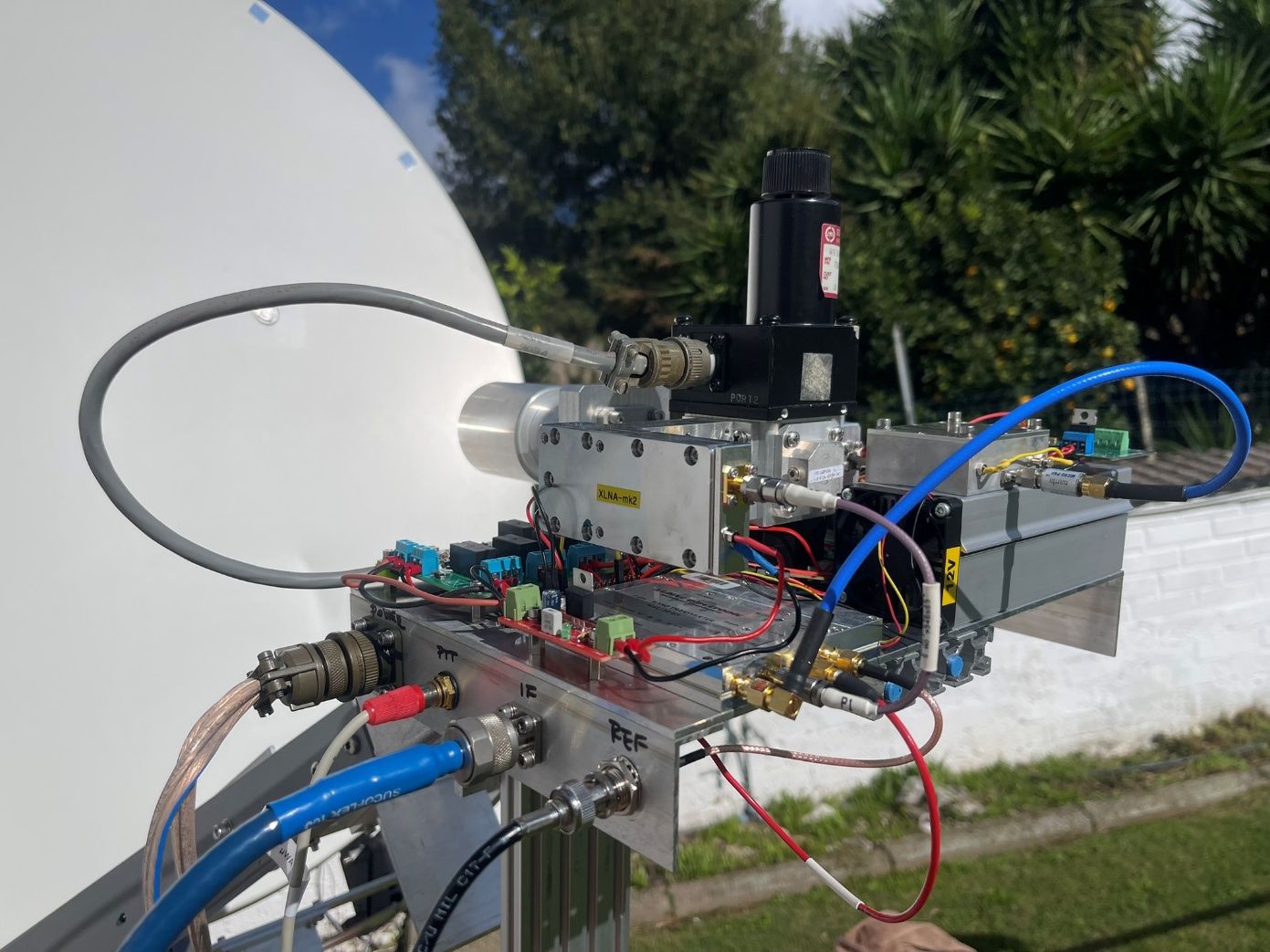 IZ0JNY New 3cm System
IZ0JNY New 3cm System
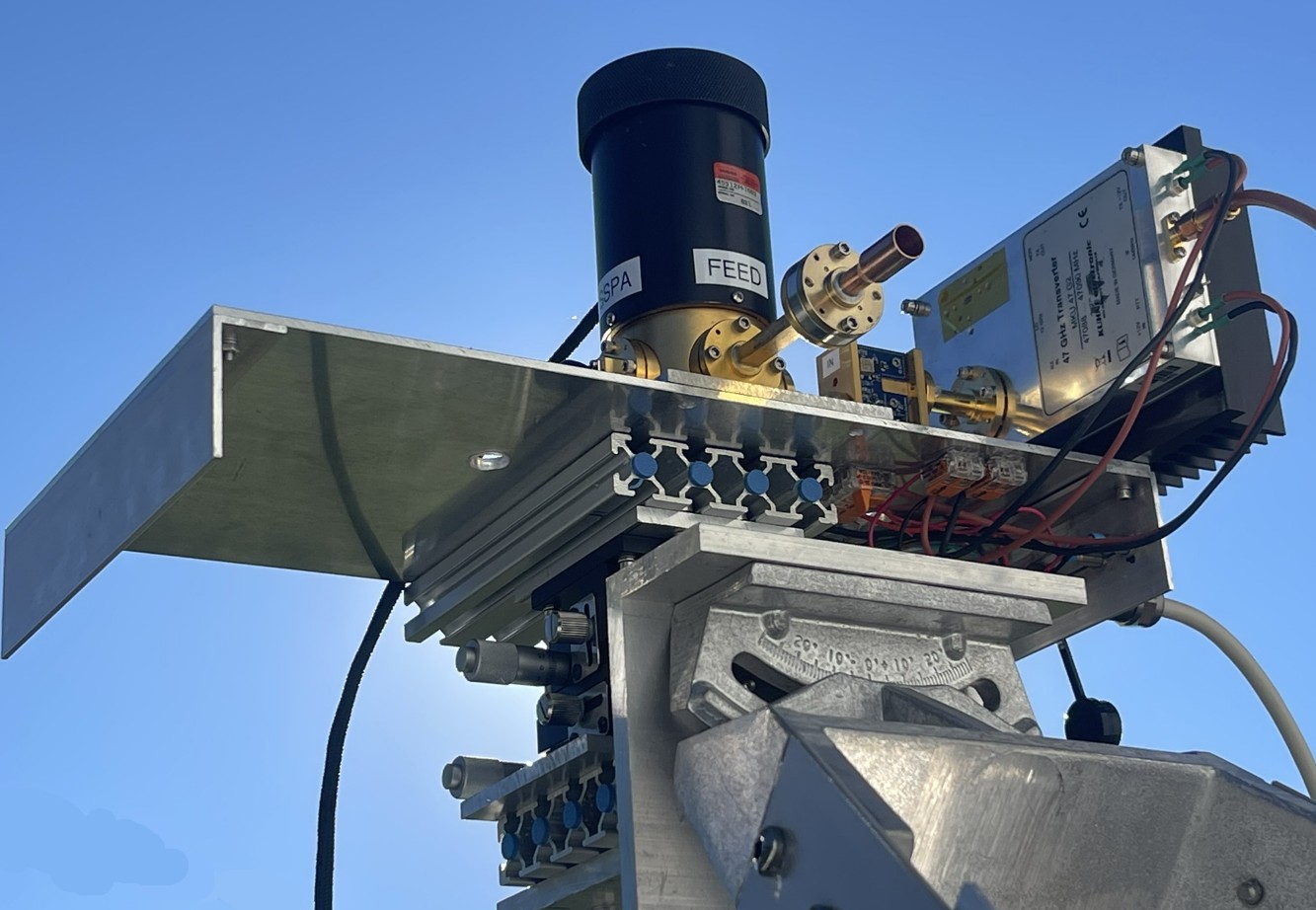 IZ0JNY New 47 GHz Rx System
IZ0JNY New 47 GHz Rx System
 IZ0JNY 24 GHz Decodes of JA8ERE
IZ0JNY 24 GHz Decodes of JA8ERE
K0PRT DSES
The ARRL EME 2025 contest was the best contest for K0PRT station in years. We finished with a total QSO count of 215, however only 174 were counted towards the contest. The rest are just dupes. Still, 174 QSOs during the EME contest was the absolute record for K0PRT. Thanks to our multi-operator team from two continents (North America and Australia).
Without any doubts we had a blast operating and working with small stations around the world. The RF output power used for most of the contest was between 10 W to 100 W. Even 5 W was enough to make a Q65 QSO with most participating stations. There were a few highlights from last contest weekend where we worked PA3DZL who used a double bowtie antenna, and a few others who used a single yagi. It's always a pleasure giving the small station a chance to participate in the EME contest.
K0PRT total QSO count:
CW 6 QSOs
SSB 1 QSO
Q65 167 QSOs
TOTAL 174 QSOs
TOTAL 134 GRIDS
SCORE 2,311,600
 K0PRT QSO Count vs Day
K0PRT QSO Count vs Day
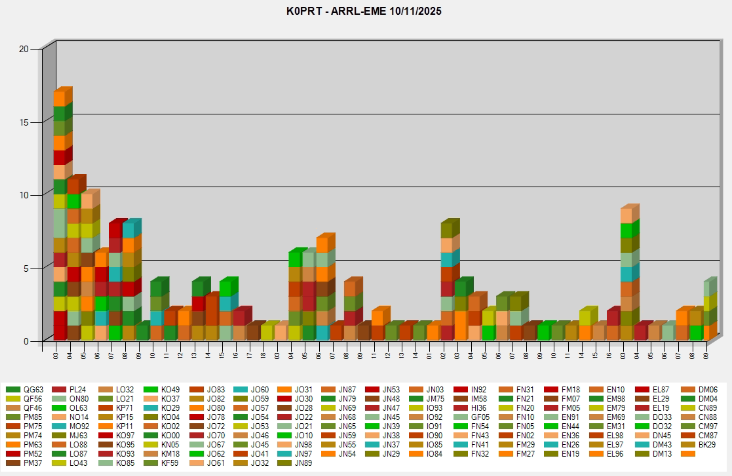 K0PRT Grids Worked vs Time
K0PRT Grids Worked vs Time
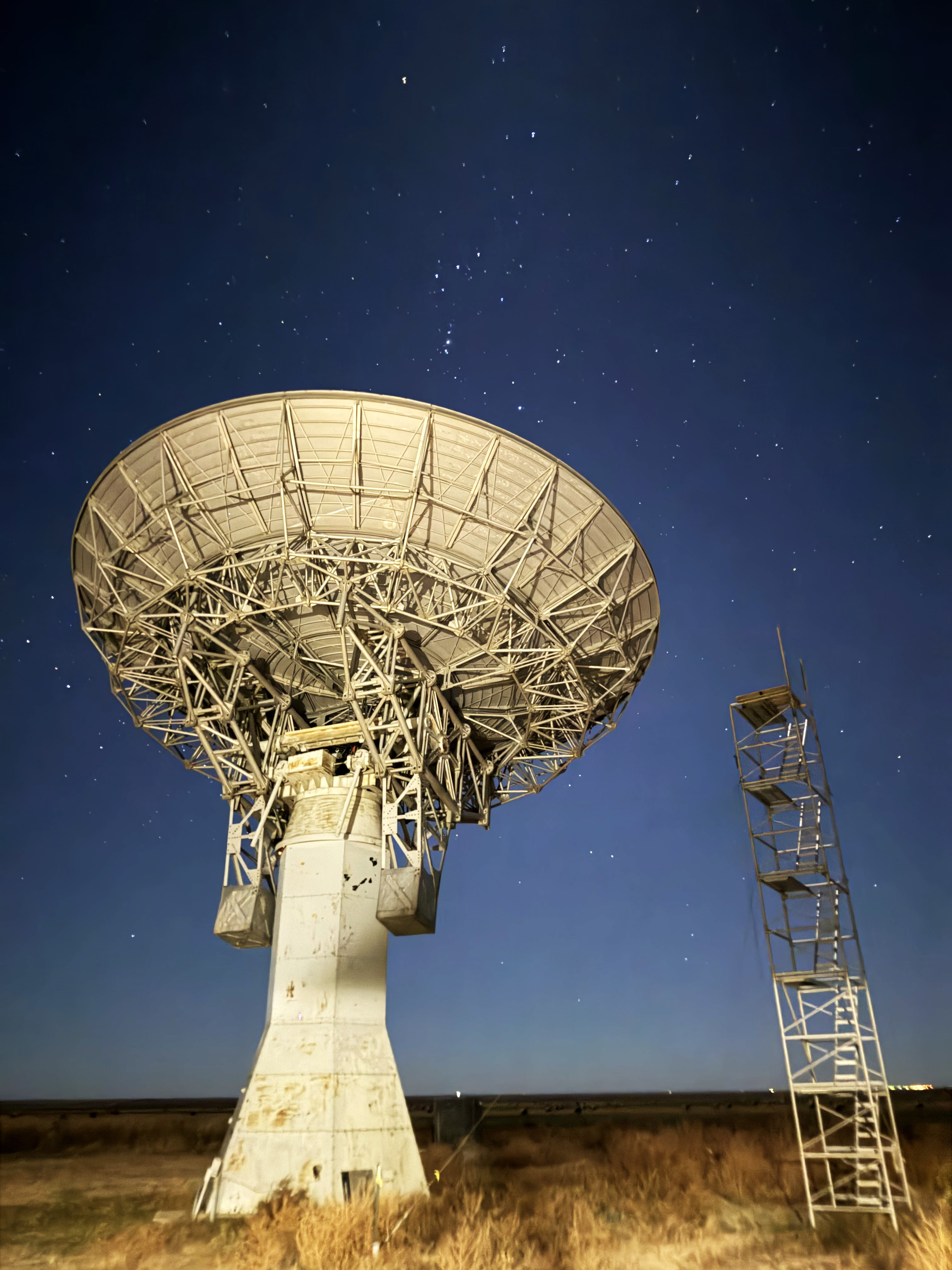 K0PRT Antenna ARRL EME
K0PRT Antenna ARRL EME
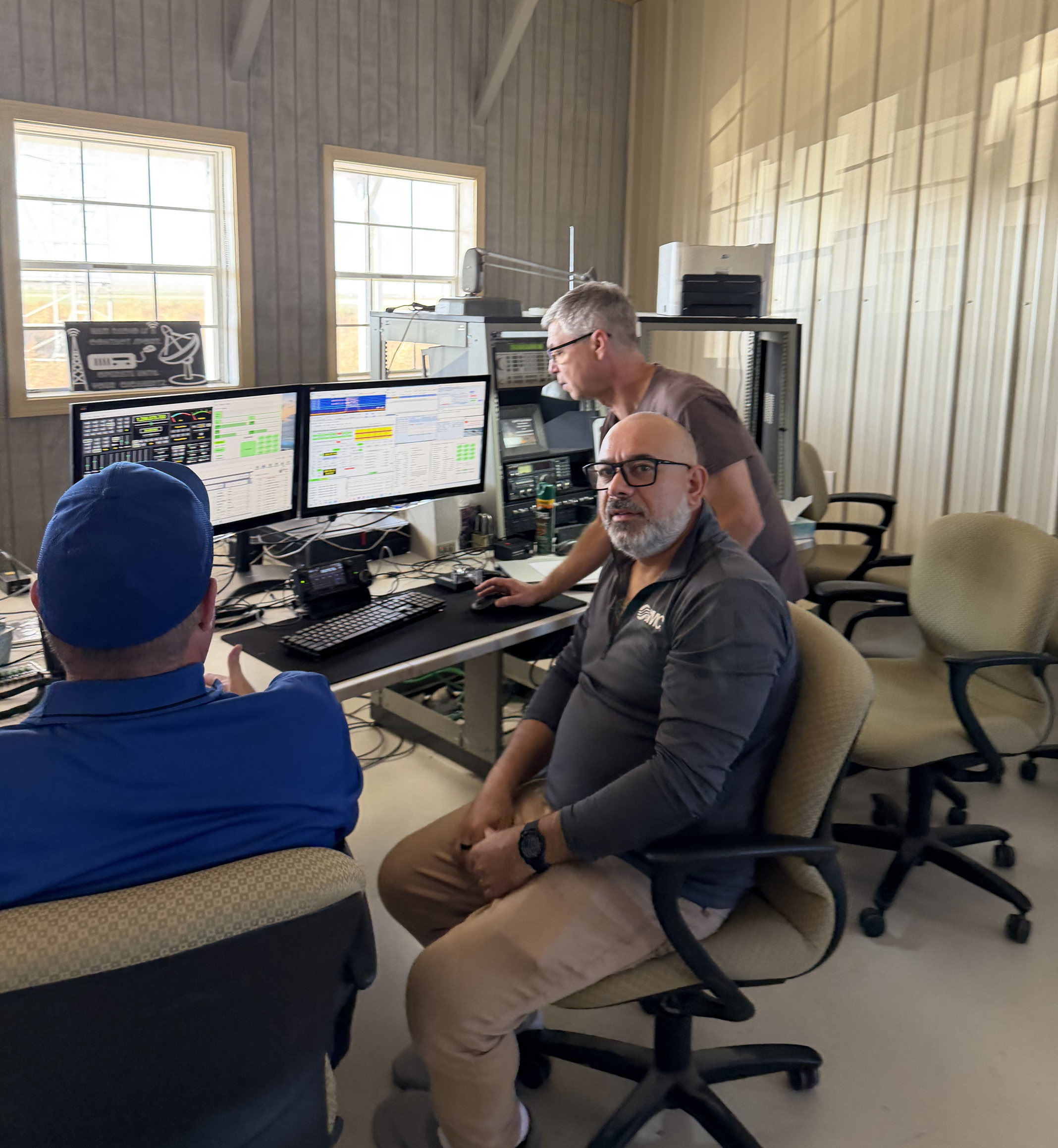 K0PRT OP position K6VHF W6BVB
K0PRT OP position K6VHF W6BVB
The K0PRT operating position with K6VHF (facing camera) and W6BVB behind him.
K1DS Rick
After a 3-year hiatus, I managed to get everything back together for the last ARRL contest weekend on 23 cm with my Sublunar 2.4 m dish & OK1DFC feed, PE1RKI 250 W SSPA and WD5AGO preamp. My moon exposure is east from 20-90 degrees elevation, working on looking west in the future.
I am so happy to have so many new initials and contacts with old friends. I am so grateful to the EME community for all your support and encouragement, parts, ideas and help. I QSOed 29 digital and 1 CW. DF3RU, K0PRT, OE9ERC, SP3YDE, W4ATC, IQ7DB, RD4D (strongest -4 / -7 wow), I2FAK, OH1LRY, OK2DL, DL4DTU, DL0SHF, UA4AAV, OK1DFC, W2ZQ, AC2AC, IK5VLS, W3SZ, N6NU, YO2LAM, OK1KKD, N1AV, OK1USW, DL3EBJ, K5N, PA3EXV, OK1UGA, GM0PJD, UA3PTW and 1 CW with KL6M O/RO. Hope to add 13 cm next year from EL96 in Florida.
K8ZR Tony
I was unable to be QRV for the first weekend of the 50 MHz - 1296 MHz ARRL EME Contest because I was on my way to attend the MUD2025 conference. The weather was decent during the November weekend and there was plenty of activity. In total I worked 58 stations on 1296 MHz including KL6M and G4CCH on CW. Despite only being QRV the second weekend, it was my best score ever by a long shot.
I worked: OK1UGA, SP5GDM, OE9ERC, RD4D (digi #), K0PRT (digi #), W2ZQ, UA4AAV, SP3YDE, WA3RGQ, N1AV, N0AKC, DL3EBJ, W3SZ, I2FAK, IK5VLS, UA9FAD, DL1HUH, ES3RF, R1NW (digi #), KB7Q, IK2DDR, ON4LX, KB2SA, IQ2DB, DF3RU, OK2DL, N4BAA (digi #), OH1LRY, KG0D, K6FOD, KH6FA, K5N, N5BF, AA6I, DL0SHF, SP9VFD ( I had the pleasure of meeting Raf @ MUD2025), OK1DFC, OM4XA, W3TI (digi #), PE1LWT, AC2AC, K3SK, ZS5Y, UA9YLU, YL2GD, W1FKF (digi #) G7TZZ, YO2LAM, PE1CKK, DL7UDA, PA3HDG, OK1KKD, VA7MM, OK1USW, PA3EXV, KL6M (CW), G4CCH (CW) and PA0TBR.
Working conditions here: 300 Watts to a 3 Meter TVRO dish. It sure was fun!
KA1GT Bob
For the November 2025 EME contest weekend I continued to operate using Q65-15A, making 34 QSOs, which added to the 24 QSOs from last month makes a total of 58 QSOs using Q65-15A. I only operated sporadically over the two days and since nobody else was using 15A, all my 15A contacts were replies to my CQ calls. While 58 QSOs isn't a large number, 15A has a few factors which currently reduce QSO count. First, anyone still using WSJTX 2.7.0 cannot decode Q65-15A transmissions. Second, those using QMAP or Live CQ to spot CQ calls will not see Q65-15A calls since neither will decode or record them. So with those restrictions and limited hours of operation, 58 QSOs isn't that bad of a total.
I was running about 240 W to a 3.1 m dish, so I'm not a big station. Nevertheless, I worked everyone who called me, and all initial decodes were single period decodes without AP assistance (Q0). Q65-15A is a very viable EME mode on 23 cm for most stations. I worked small stations including a 1 m dish and several 1.5 m and 2.4 m folding dishes. I also worked a few stations on 30B who were still running WSJTX 2.7.0 or earlier versions and who requested a contact using 30B.
Only a few years ago everyone was on 60C. 30B was pretty much ignored. When I started using it in the EME contest (2021 I think), I was just about the only station using 30B. In this year's contest, most stations on 23 cm were using Q65-30B. I'm not sure if 15A operation will (or even should) reach the same level of usage, but it could. It's not for real QRP stations who may need 30B, 60C or even 120D to make a contact, but it works well even for fairly small stations. I don't know if QMAP will ever support 15A for EME, but all future (and the current 3.0.x versions) of WSJTX will support it. Nonetheless, give it a try once you have upgraded from 2.7.0. You might be surprised how well it works. QSOs are faster (<90s), making it easier to move around and make QSOs if your operating time is limited, and the PA runs cooler. If a signal is -20/-21 or stronger, you can expect a single period non-AP assisted decode. For more info see:
https://bobatkins.com/radio/Q65-15_eme.html
https://bobatkins.com/radio/Q65-15_eme_II.html
https://bobatkins.com/radio/Q65_15second_modes_EME.html
On another topic, the results of a survey of opinions on the EME contest are available here:
https://bobatkins.com/radio/EME_survey_1.html
Clearly not everyone is happy and most want changes to both the scoring system and the rules. Exactly what changes would make everyone happy is debatable, but it looks like a change to basing scoring on grids and requiring a signal report exchange would make the least number of people unhappy. I believe this will likely be the official scheme for the 2026 EME contest, but we will have to wait and see about that.
KB2SA Bill
KB2SA (Bill) participated in the ARRL 23 cm EME contest with his new 1.0 m mesh wire dish.
Over the 4 contest days, Bill completed 114 QSOs with 104 uniques. He used two monitors with one monitor dedicated to a wideband QMAP waterfall and decode display to help find "hidden" operators.
Details for this new 1.0 m 23 cm antenna will be published in DUBUS January 2026.
 KB2SA operating position
KB2SA operating position
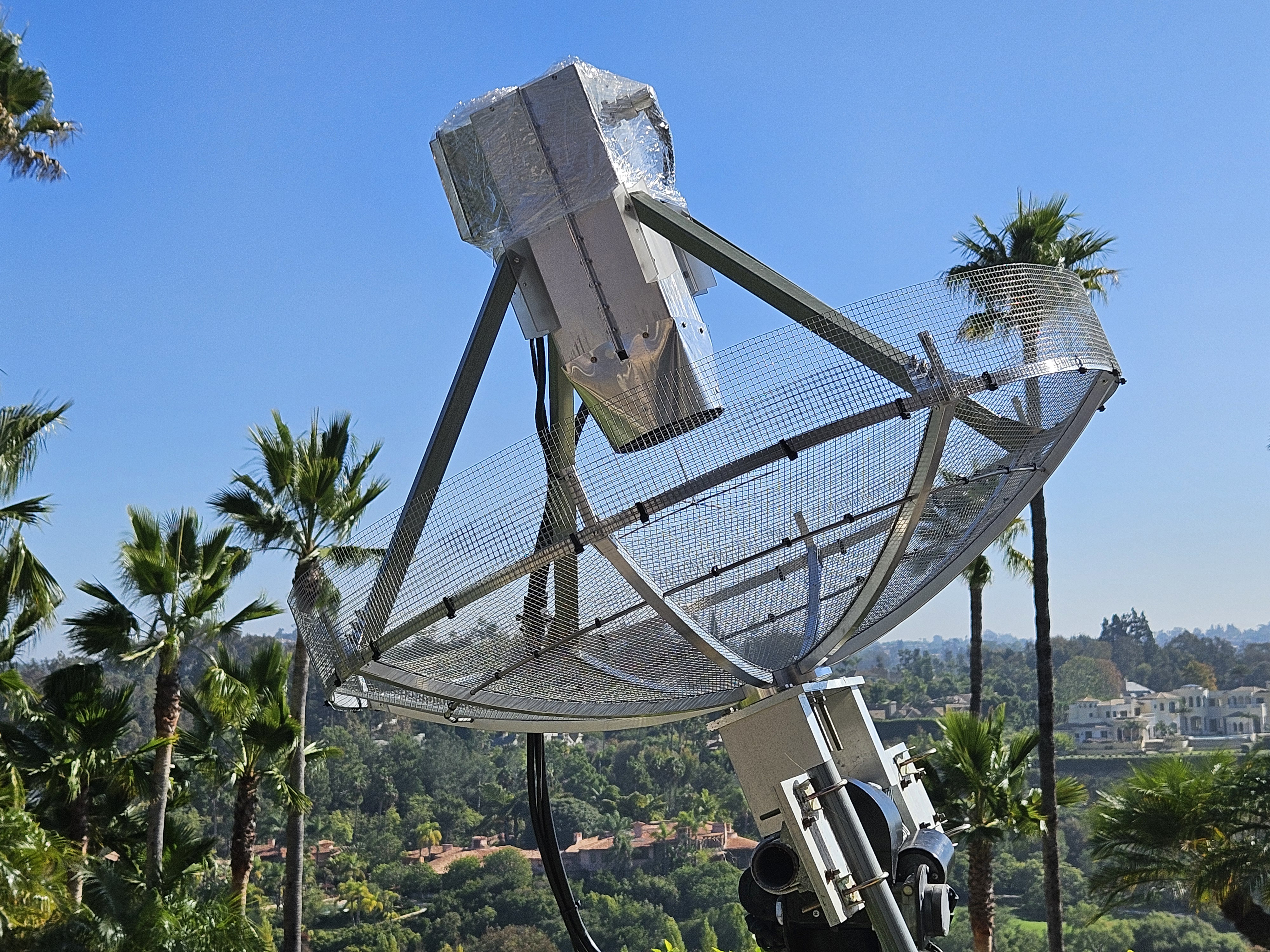 KB2SA 1 m dish for 23 cm
KB2SA 1 m dish for 23 cm
KB7Q Gene
November was a great month for 23 cm EME. Between pre-contest activity and the ARRL contest itself I managed to log 16 new-to-me stations. They were GW4ZHI (-27), W3IPA (-21), W3HMS (-15), WA4LM (-16), DL3EBJ (-12), SO5AZ (-26), UA4AAV (-12), W4ATC (-19), W4UNU (-23), JJ3JHP (-16), VK2JDS (-21), VK4CDI (-24), ZS5Y (-26), YL2GD (-17), RX3DR (-22), R1NW (-29). This bumped my initial station count to #248.
The contest weekend was terrific fun, I cranked up the barn's propane heater, and threw a maximum effort at it to take advantage of the super moon and all the tremendous activity. I logged 85 stations. My Log submittal to the ARRL was super easy this year. My 23 cm station: 1.5 M dish, 400 watts, AGO Preamp.
KD2XN Phil
Since my last NL submission, I’ve upgraded WSJT-X to v3.0.0-rc1 and spent just under 2 hours participating in the 2nd leg of the ARRL EME contest. I worked 9 stations on 23 cm with Q65-30B using a 2.3 M mesh dish and 180 W at the feed as follows: JQ3JWF(-13/-19), WA3RGQ(-16/-17), W2ZQ(-12/-18) op: Joe K1JT, W3TI(-21/-22), JJ3JHP(-11/-15), WA3GFZ(-19/-21), N1AV(-14/-15), WA4LM(-18/-24), AA6I(-14/-14). Thank you Hari for my 1st JA EME QSO!
As of November 2025 my EME QSO stats are as follows; Total QSOs 94, Initials 84 and DXCC 22. Looking back to earlier this year, my 1st 23 cm EME QSO was with KD5FZX on 25/3/2025 using Q65-60C. Thanks Mats – what a thrill that was!
See my QRZ page for station info. See you off the moon!
KG0D Dave
1296 EME ARRL 2025 Contest Summary at CN88KA for KG0D. Worked six hours of moonrise late the first night and another day six early hours of moonset for 52 contacts all over the world. Testing the 1.5 m "Solar Cooker" dish with OK1DFC septum and experimental 100 mm x 200 mm diameter flare with a WD5AGO ULNA. SSPA is homebrew using the W6PQL pallet with a measured 400 watts at the septum. Radio is the IC-905 - all out on the platform under the dish. Dish AZ/EL tracking is with a three inch slew drive and WinTrak.
I use a simple dish size times power calculation for overall EME station size comparisons. My station is 1.5 x 400 = 600. I worked 10 stations equal to or smaller than that, the smallest 240. Smallest dish size worked 1.0 m KB2SA, -20/ -22 . Two other solar cooker dishes worked: KB7Q -23 / -21 and NY1V -23 / -24. Also worked SO0AZ, 2 m dish -23 / -22. Largest dish worked 18.2 m K0PRT. Looking at the averages for my 52 QSOs, the average dish size was 4.1 m, average power, 438 W and average reports -23 / -26.
The station is battery powered and as 96% of QSOs were 30B or 15A this helped extend battery life.
Several attempts were made to work 8Q7UM. We tried at my moonrise and again at my moonset. Barriers at each end (concrete wall for Alex, buildings/trees for me) prevented a contact during our brief footprint overlaps. I used the iPhone app, “Theodolite”, to review the tree line elevations for the potential 8Q7UM contact, see picture.
Great Fun and looking forward to doing it again!
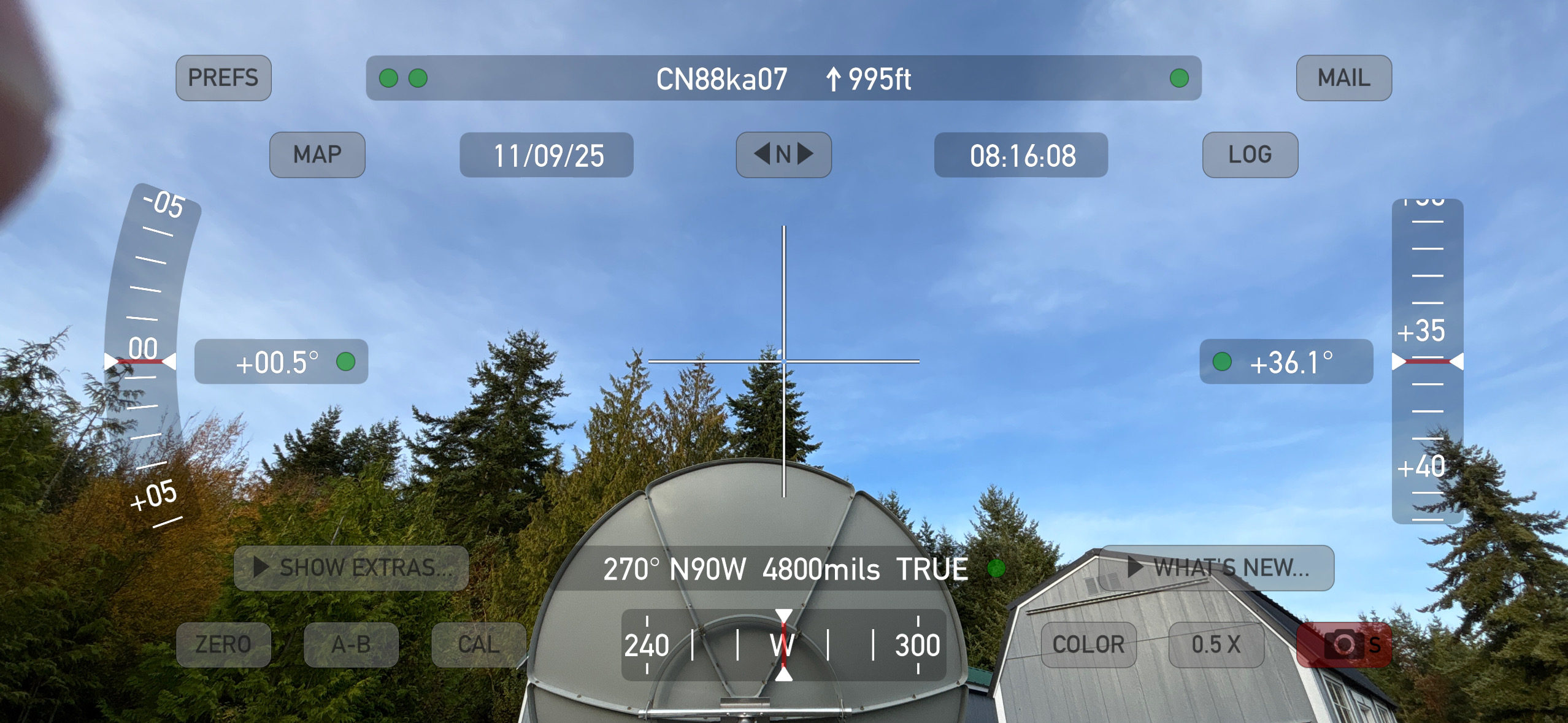 KG0D Moon Theodolite to West
KG0D Moon Theodolite to West
 KG0D Dish Side View
KG0D Dish Side View
KN0WS Carl
I did both 23 cm and 70 cm during the October leg of the ARRL contest and planned to try the same in November. The forecast called for some snow and cold air. I did indeed get a dusting of snow and the night-time temperatures of 24 F degrees one night and 18 F degrees the next was quite hard on me! I am surprised how fast I seem to be losing tolerance for my outdoors tent setup. I ended up quitting earlier each night than I had intended, and the cost was that I did not get to work any VK stations - I apologize to my friends down under.
In spite of that, and having one generator quit the first night, only to see the backup generator fail the second night, I was able to work 35 QSOs on 23 cm, including 2 CW QSOs and 12 initials with 8Q7UM, K0DSP, DL1HUH, S0SAZ, SP7EXY, RA9FLW, DK3EE, W4UNU, W6TCF, W2LPL, N6NU and OZ3Z.
On 70 cm, I had 16 digital QSOs including initials with DF6LH, W4HFZ, DK0TE, DC1RDB, K7ATN and PC0A. That brought my contest totals up to 3 cm: 16 x 14, 13 cm: 13 x 13, 23 cm: 88 x 77 and 70 cm: 26 x 23 (final 143 x 127). As per usual, I had equipment issues and missed opportunities but had a good contest. Thank you, everyone.
This completes my 2025 EME activity. Over the year I did 12 moon-passes on various bands, plus one sked. I had 206 total QSOs, including 58 initials, bringing my 13 year total QSO count up to 1350. At some point I need to get real logging software instead of using my spreadsheet! My beloved 20 foot dish was scrapped, but I now have interchangeable feeds for my 16 foot polar mounted dish and I have done a bit of resurfacing of my smaller home dish, so hopefully I am set for 2026. Have a blessed holiday season!
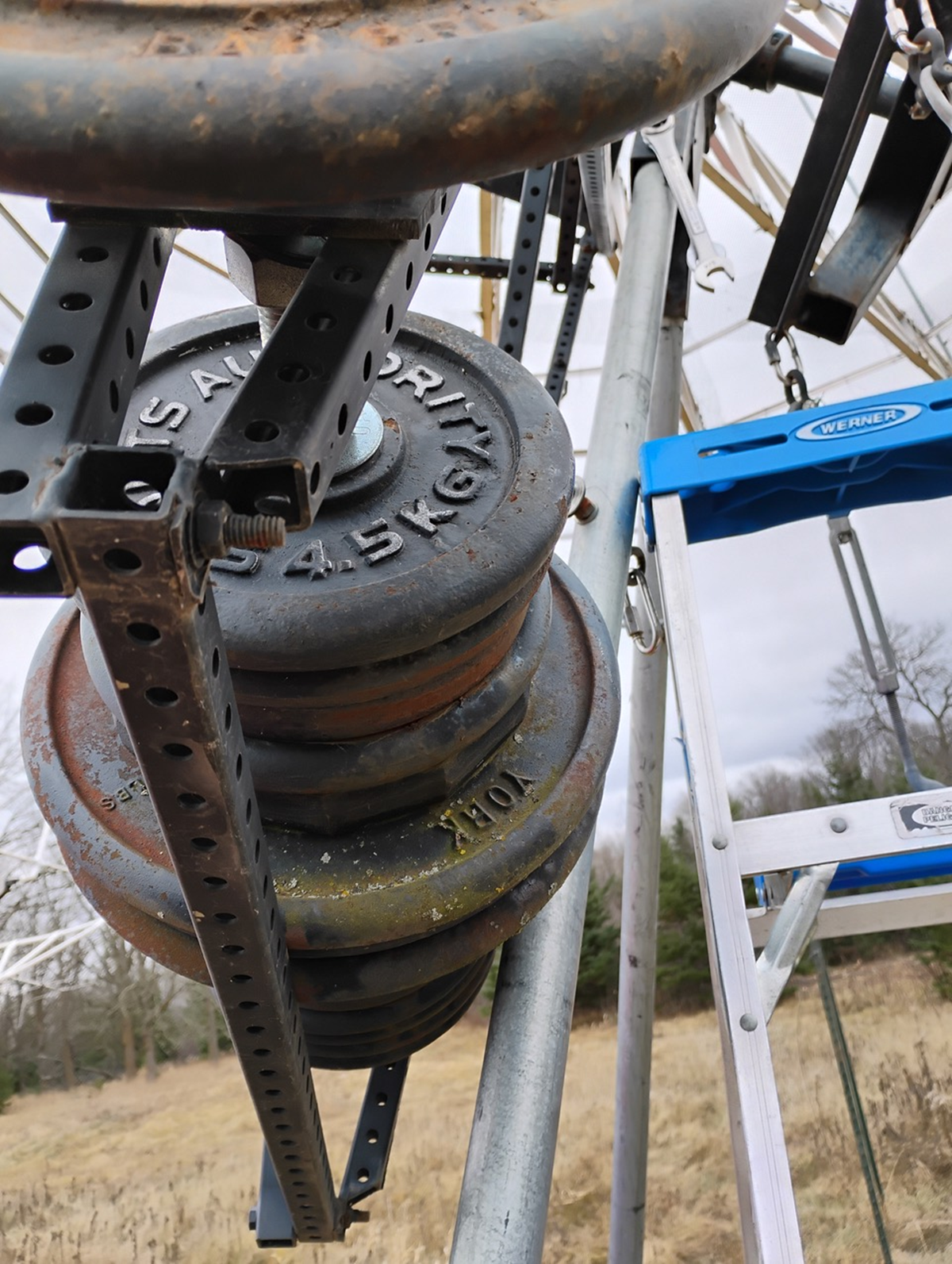 KN0WS Counterweights up against mount
KN0WS Counterweights up against mount
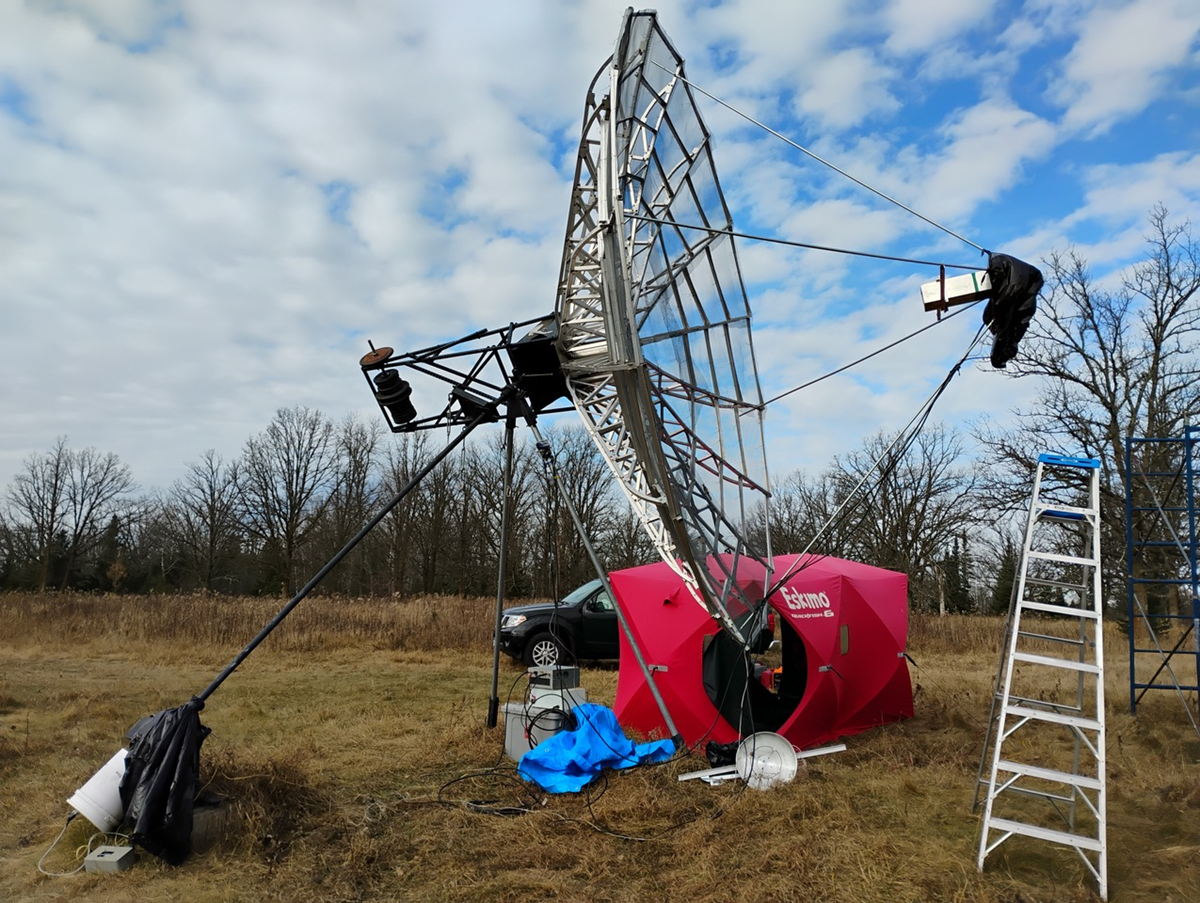 KN0WS portable location with 4.5 m dish
KN0WS portable location with 4.5 m dish
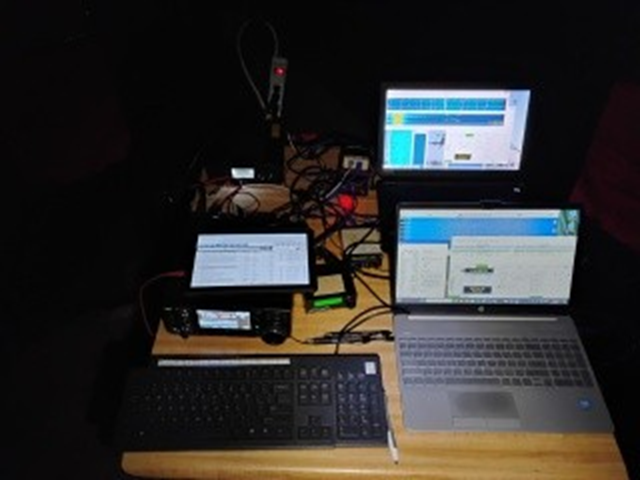 KN0WS Dark Little Station
KN0WS Dark Little Station
N0AKC Charles
23 cm has been playing great - I made a total of 84 Qs there over the two contest weekends. The contest effort here this year was a multi-op with K9MU & KA9OMY. Steve, KA9OMY had never operated EME before, but has always been fascinated by it so I invited him over the last weekend and put him on 23 cm. He had a great time! During the second weekend of the ARRL contest I managed 8 new initials on 23 cm: DL4DTU, DL1HUH, UA4AAV, N4BAA, W4ACT, SO5AZ, OZ3Z & OK1KKD. W4ACT was also a new state for me (NC).
I finally managed to work out all the issues on 70 cm and got on that band the final evening where I managed 6 new initials: DF6LH, SP2WRH, ON7EQ, PA0PLY, SM4GGC & KN0WS.
For the contest I managed 140 Qs in 135 grids for a total score of 1,998,000 points. I had 3 more Qs than last year, but fewer grids, so my score was down slightly from last year. I continued to be plagued by problems on 222 & 902 so I was not able to make any QSOs on either band.
I am continuing to collect parts for a 10 GHz EME station and hope to be on that band next summer.
N1AV Jay
Another EME contest is in the books. The ARRL 2025 International EME contest was a heck of a thrill ride. Modes used WSJTX 120D, 60C, 30B, 15A, 51 second JT65, Q65, & CW - options galore! This year for the EME contest, I put in my biggest effort to date, and by the score I produced it looks like the efforts paid off. For those that know me, I am very competitive. When I get a goal in my head it consumes me, even if it seems impractical or impossible to others. That just pushes me harder. Combine that with a hobby where you are forced to always be learning new things... Oh boy! That can be exciting!
So, how do I do EME out here in Arizona? A few folks have asked for a picture of my setup, especially the yard with the antennas when they heard about my raw score. It isn’t anything special, just a lot of aluminum crammed into a small place. All the arrays and dishes are placed in about a half acre (0,2 ha) of land. There is and was no logic to where something went, as this was a totally organic growth project. The arrays ended up being where they were based purely on where there was space to put them. If I was to do it all again, it would be arranged completely differently! But, we all have to work with what we have, and hindsight is always 20-20. The metal barn directly to my east requires me to wait until about 5-6 degrees of moon before I can get active. Four years ago when it wasn't there, I had access to the moon just rising over the horizon... ahhhh... memories... but back to 2025.
I was very happy with the overall result of the contest, however, the contest for me was not without issues. Namely the first weekend of the 1296 and below weekends, October 2025. The first pass on Friday night went well. I had everything warmed up hours before the contest and I sat and watched the various loggers as I waited for the moon to rise in DM43. I see that the 1296 HB9Q logger almost has more stations logged in than I have vertical space for the browser in my monitor. 432 is not far behind. Excellent! Lots of folks to work off the moon! As the moon moves from -19 degrees to -10 degrees of moon I start to see EU stations drop off. Granted, many of you have had the moon for several hours already, but clearly there are more stations to work - why stop now? At Moon rise at +6 degrees all of my stations (144/222/432/1296) are up and running as I have a view of the moon. HERE WE GO!
Band conditions on all bands were good, and 432 wasn’t doing crazy things, so managing polarity was a reasonable effort. Friday's pass goes well, and I stay focused until about +35 degrees left until Moon Set. Once I get to about 30 degrees to the West I start to pick up all the noise of the Phoenix valley (as I am pointed into Phoenix) and my noise floor goes up by 7 dB on 432 and 144, essentially killing activity on those two bands. I ended up with decent totals on 1296 and 432, but noise plagued me from hearing the JA stations well on 144 so I bailed, knowing I could pick them up on the next pass. That plan was a mistake.
Saturday's pass was nothing short of terrible. Constant rain and thunderstorms. Any sensible person would have skipped the contest due to the weather so I watched Netflix with the XYL. All the news channels were advertising weather alerts for the area for Saturday afternoon and continuing overnight. I didn’t care, I was going to operate, thunderstorms or not. I have a contest to take part in!
For those new to the EME world that don’t know, rain on yagis makes noise. High noise keeps you from working stations. I could tell when the rain would stop as I could start to hear stations again on 432 and 144. Then as my reception seemingly became terrible, I could peek outside and see it was raining quite actively. This rain, no signals, no rain - hey, I hear again, the cycle went on for a few hours. I could see the SWR changes were causing a difference in the PA output power monitor, but neither amplifier seemed to care. 1296 on the other hand, worked just fine through the rain, aside from the lightning crashes that were filling up my Flexradio IF screen with streaks of noise. I started putting more focus on 1296 than the other two bands because I could generate more #s for the log. At one point I was calling on 144 and someone on the logger mentioned my strong echos, and then said I had FOUR callers. I could not see any of them. Nothing. I switch polarity. Nothing there either. I stopped sending and walked out of the shack. It was now about 01:30 in the morning, I had been trying to work the moon for 4 hours and maybe made 30 contacts on 144 & 432. I was well below the rate I had set for myself. Walking out of the shack and into the garage I could hear what sounded like a train roaring past me. Horizontal rain pelting the windows high up on the walls of the garage and the wind was howling. This sound is often associated with tornados or major storms with high wind and weather.
With my good arm (as my right arm was in a sling from rotator cuff surgery 3 weeks previous) I opened the door to outside and was met with a face full of water. The door knob ripped out of my hand as the door swung into the garage banging off the wall. There I am, at 01:30 in the morning, not even half awake, arm in a sling, getting completely soaked from the rain blowing INSIDE my garage. It was like a scene from a B grade thriller movie. All that was missing was some dinosaur pulling me out of the garage and into the raining swirling abyss. I could not see the arrays from the lights inside the garage shining out - all I saw was water, and a lot of it. I managed to push the door closed and went back inside the shack, now dripping wet, and realized I had now lost all tracking on the dish. I looked at the weather station and the winds were blowing over 45 MPH (20 m/s), and the rain rate was over 6” an hour. SIX inches (15+ cm) an hour! That folks, is a lot of water. Soon I lost all the signals I was decoding on the dish. I waited another 20 minutes for the winds to die down, listening to the horizontal rain slam into the shack windows and braved another peek outside. Using my headlamp I could see that the dish had slipped on its mount, blowing it off axis. With one arm in a sling, in the middle of the night, in a rain and lightning storm I knew I was not going to be able to fix it. I shut the shack down, said a few choice words, and headed to the house at 02:00 to go sleep in the recliner. My contest weekend was over, about 8 hours short of what I wanted. The next morning I went out and took some pics of the flooding from all the rain and the dish. Yep - it needed some attention. Glad I had a few weeks to get some help to get it aligned properly. (Big shout out to AC7FF, N5UC and AC0RA who happened to be in town for the MUD conference for the help!)
Knowing that my first weekend of 1296 and below was trashed and I was WAY off the score metrics that I had set for myself, I knew I had to double down and really work for every-single-qso that I could for the last two passes in November. Doing everything from changing feeds and setups to work different bands in the middle of the night on a ladder with a headlamp, CQing non stop from MR+5 deg to about MS +30 deg and squeaking out every single contact I could. I was reviewing the logger, making “missing” lists per band of those I had not yet worked on the paper pad next to me, skeding with stations that I knew had more than one band and hopping from band to band to work them. I also did a lot of opposite timing, (Calling 1st on some bands but calling 2nd on others) and no breaks aside from ‘watering the desert’ in the middle of the night from all the coffee and seltzer water consumption. Financially speaking, the great news was that all the amplifiers kept their magic smoke on the “inside” this year and didn’t release it compared to previous years. That was a great stress test.
I made several ergonomic changes due to 1 arm being in the sling about a week before the October weekend and that paid off. Shack ergonomics matter! It is amazing how tired you can get from just repeating the same movements over and over and over after being up for dozens of hours - (especially if your shack is spread out, or not designed for contesting) such as turning in your chair to look at a monitor or a meter. I spent a lot of time over the last year to eliminate extra movement and just be able to stare forward at the 4 screens that had the 4 bands I was running. It isn’t perfect, but it is a lot better than last year. #alwaysimproving.
I ended up doing a lot better than I expected on some bands, and a little off the mark on others. But, that leaves room for improvement, and with Zdenek already throwing down the gauntlet with him saying he will be adding 144 to his stable of bands for next year, I need to step up and add 9 cm and 6 cm to take advantage of some points there, as well as continue to refine the 70 cm and 2 m stations. (That and make some sort of non-living sacrifice to the rain gods to stay away during contest weekends! Maybe I can sacrifice a Baofeng or an LED bulb, or some other noise generator...)
All in all, the hundreds of hours I put into improving my station this year paid off. From the big haul on 3 cm to really good numbers on 23 cm and 70 cm. I have already started working on station improvements for next year, now that my arm is OUT of the sling - hooray! First step is changing the shack focus from a terrestrial contest station 1st, EME contest 2nd, to an EME contest first, terrestrial activity station second. That means a new bench design, probably close to 100 yards of wiring to be moved, new IF rigs, new to me transverters, new fancy software do-dads that save time, a new dish (or two) and finding some more internal competitive motivation should make the SOAB category of the 2026 contest one heck of a competition. I am also working on my setups so I can accommodate more CW in the contest, which equals more points.
Thank you all for the contacts, the patience and being on the moon for the contest. Especially the patience for the 2 CW Qs I made. Going to CW totally disrupts my all digital multiband operational flow, but you two guys were so loud I had to do it.
EME is the ULTIMATE DX endeavor!
Raw scoring breakdown for N1AV - DM43 Arizona.
 N1AV scoring summary
N1AV scoring summary
Total: Raw Score: 12,445,600
Remember : If it was easy, everyone would do it, and it would not be any fun. See ya on the moon!
Jay, very best wishes from the EME community for a full recovery. Ed
 N1AV dish slipped on mount
N1AV dish slipped on mount
Dish slipped on the mount, completely out of balance. Yep, that isn’t going to elevate!
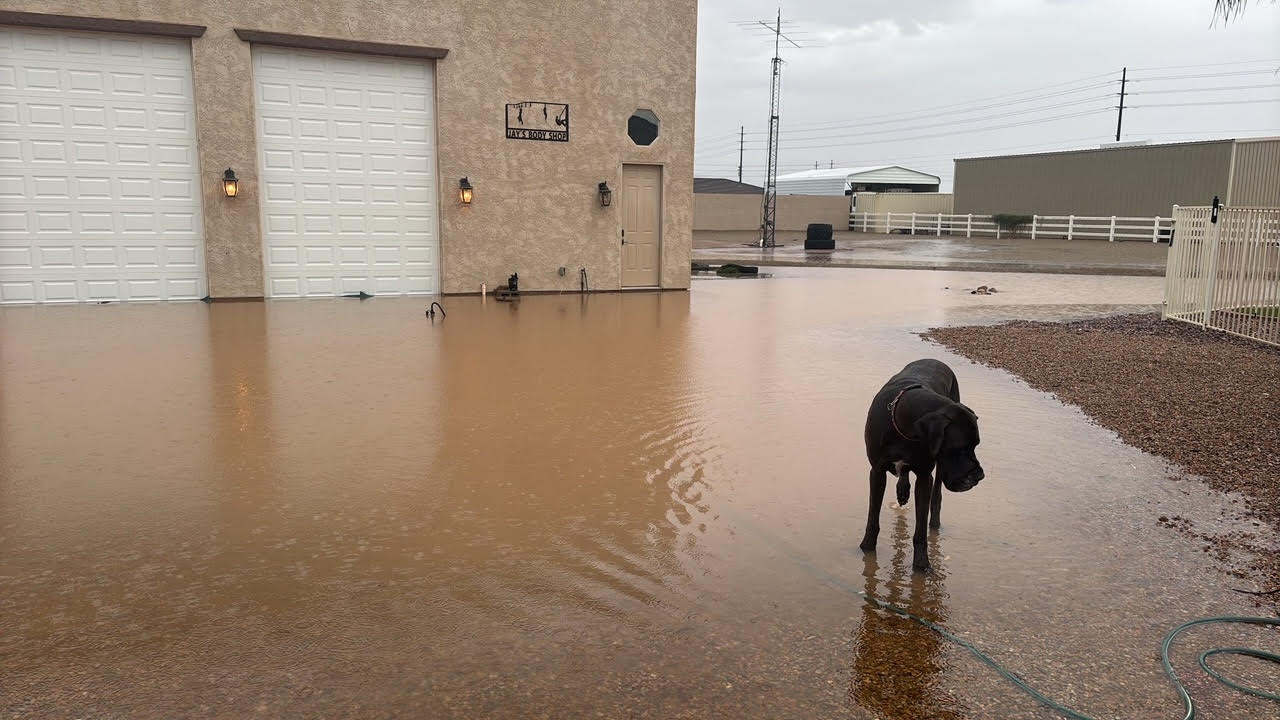 N1AV flooding outside garage
N1AV flooding outside garage
 N1AV flooding inside shack
N1AV flooding inside shack
 N1AV operating position
N1AV operating position
My extremely disorganized post contest view of the operating position (Four 50” LCD TVs used as monitors) - for those paying attention, yes, I did move the mouse BACK to the right side of the keyboard, now that my arm is OUT of the sling.
N4BAA Jose
Even though I am not optimized to where I think I can be... I enjoyed some good activity since our last month's reporting and I am loving 23 cm EME!
I will not list ALL the wonderful stations that are new "initials" but I now have 120 QSOs and 91 unique "initials" - Including 8Q7UM and JS6UJS (Okinawa) who found me as well. AMAZING! Also, I was able to connect with RA9FLW who was just running 50 watts.
Most notably this month was my first 23 cm CW QSO with my Mentor and friend KL6M. Thank you Mike for your patience, guidance and friendship!!! I am very appreciative more than you know in getting me up and running on EME. Next stop? A 2 M EME array has already been started!
In the ARRL EME contest, I decided to dabble a bit and had 71 QSOs in about 12 hours of on air time. I have everything I need to support running QMAP very soon.
Thanks to everyone who has been SO supportive, and I look forward to each moonrise. It is simply amazing to think about what an amazing feat it is to be able to communicate via the moon! We are a very unique breed indeed. 😁
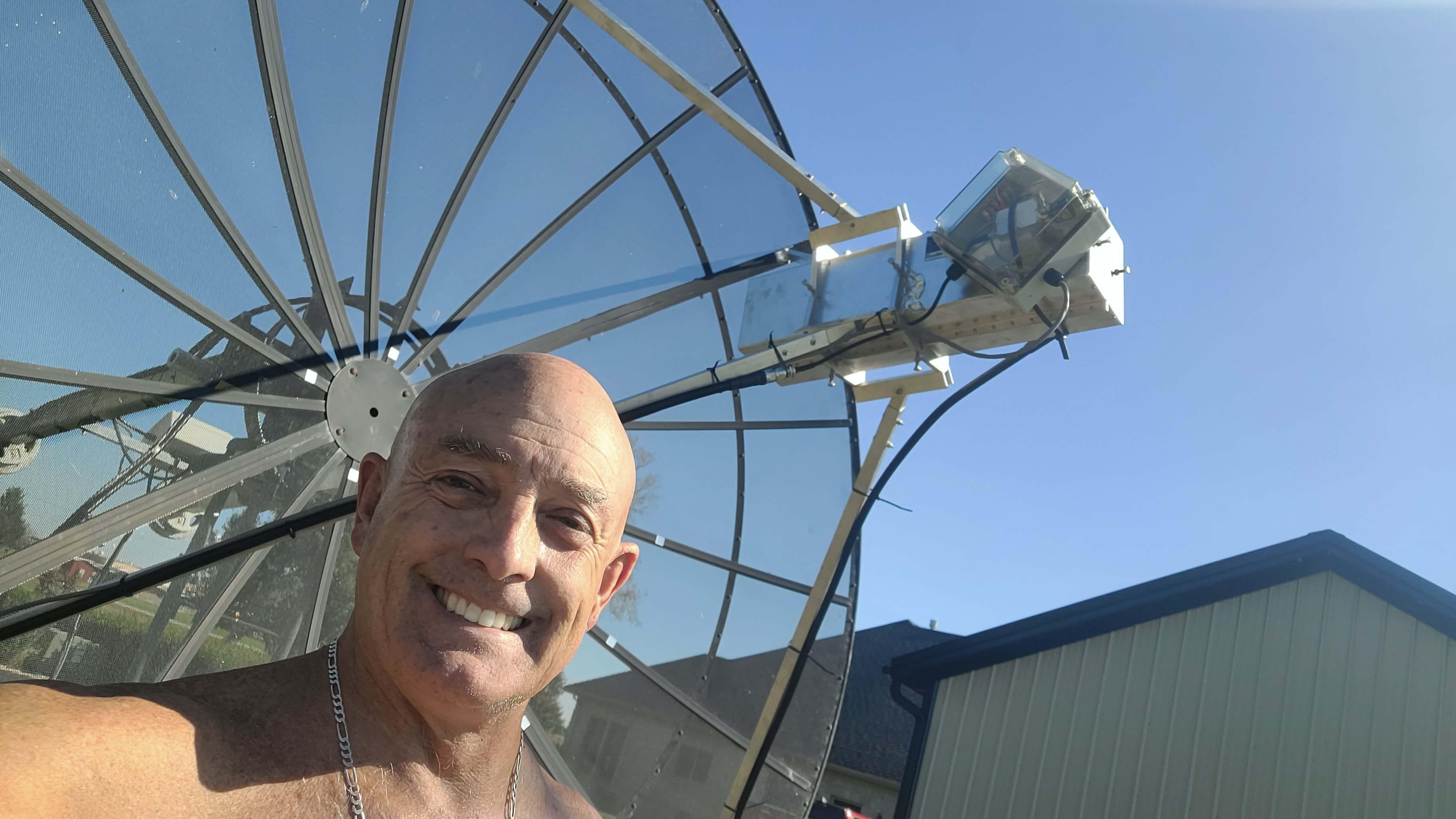 N4BAA with his dish
N4BAA with his dish
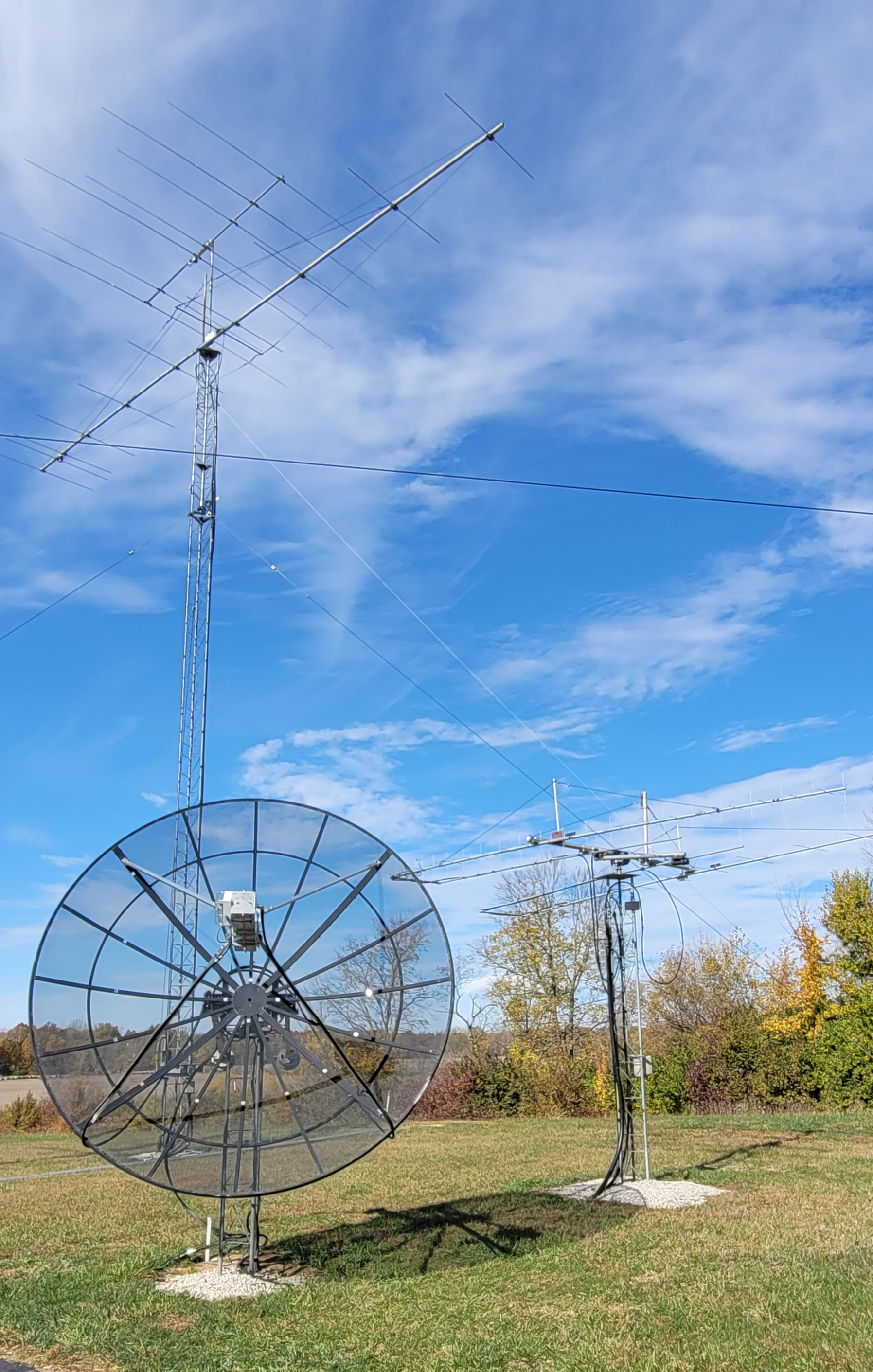 N4BAA antennas
N4BAA antennas
N5BF Courtney
Following a late Friday equipment failure a few hours before moonrise in the November weekend, I was able to go to a lower power backup system just in time. New initials in November were W4ATC, OZ3Z, and my neighbor K6FOD in DM04 who I could also see quite well on the uplink. This was a folding dish to folding dish QSO as well. Performance to the west is always poorer from this location due to foliage and other blockage, but I did complete with UA9YLU on Sunday morning local time.
Final results this year were 50 non-duplicate QSOs in October and 21 in November for 71 total with 64 multipliers. Despite the small station limping along, I had a great time! Checking my year-to-year statistics, I noticed that this was above median performance for all ten years I've been doing the ARRL contest on 23 cm EME. I also noted that using grid squares as multipliers means that the number of multipliers is around 90% of the number of QSOs. Using DXCC / States / Provinces, the ratio is around half, something to keep in mind when comparing scores over the years.
NC1I Frank
I was deeply saddened to learn of the passing of Jurgen DK3WG. My first EME contacts with Jurgen were on 70 cm back in the very early 80s when he held the callsign of Y22ME. Over the years I have had well over 100 QSOs with him on 70 cm & 23 cm, our most recent was on 12 October 2025 on 70 cm. I had the pleasure of meeting him at the EME conference in Paris in 1998. He was a true gentleman. He had helped many of us over the years with paper QSLs in and out of eastern Europe. The EME community has lost another giant.
Initials worked since my report last month:
On 23 cm: 8Q7UM, N4BAA, WA4LM, K4UGO, F5AOL, LX/ON4MU, and DC1RDB
On 70 cm: 7M2NZN, JH8FIH, JA7KPI, BI6DX, DJ7FJ, N4KDX, RW3PX, ON4APU, JF9RTX, and JQ3JWF
It was a pleasure to work two DXpeditons on 23 cm, 8Q7UM (new DXCC for me) and LX/ON4MU. Thanks guys!
OE3JPC Hannes
Since I was asked to write a short report about the first part of the ARRL EME-contest (50-1296 MHz) my motivation temporarily increased and I decided to be a bit more active during the second weekend. Temporarily, because Mr. Murphy had to visit me the evening before the contest started, my SWR on 23 cm was poor and I did not want to climb up the tower during the (cold) night. Nevertheless I worked OE9ERC and W2ZQ.
In the morning I opened the relay/power splitter/LNA box. When I removed the cables from the power splitter something fell out and ended up somewhere in the grass of the garden 15 m below me! It was one of the N-connectors of the (homemade) power splitter that simply had broken off. Guess who I blamed for that poor solder job?
After a long search for that connector (why didn't I mow the lawn as my XYL asked me for 2 weeks ago?) and after repairing the splitter all worked as it should. However, I missed the first American window.
Here are the results:
23 cm with 2x56 el. YU1CF / 400 W @ant: 1st weekend 18 stations, 2nd weekend 37 stations (plus 3 double contacts - sorry, I didn't check) = 55 stations. Life is hard with just 2 yagis but I am quite satisfied with that result.
70 cm with 4x24 el. DJ9BVopt / 1kW @ant: 1st weekend 12 stations, 2nd weekend 13 stations (plus 1 double contact - again sorry, I didn't check) = 25 stations
Unfortunately, the activity on 70 cm is really low. That is disappointing however as installing 2 long yagis and 100 W (the more the better of course) is not such a big challenge.
OE5VRL Rudi
On October 31, 2025, from 16:23 to 17:02 UTC. I was able to QSO Ari OH3LWP on 5 bands in 40 minutes! These QSOs were a great pleasure, and it happened by chance. I was using the HB9Q logger because I was testing a new preamplifier on 13 cm. On the 10 GHz chat, I saw that Ari was transmitting CQ, and we got into a QSO even though my polarization was incorrect. On the HB9Q logger, I saw that Ari was active on 5 bands, so we then did 13, 9, 6, and finally 23 cm.
My QTH is at 866 m above sea level and quite exposed. Since 2006, I've had the 3 m solid parabolic antenna on the mast at a height of 17 m. I use the dish for 70 cm, 23 cm, 13 cm, 9 cm, 6 cm, 3 cm, 24, and 47 GHz. The transverters and power amplifiers for 23 and 13 cm are behind the 3 m dish, and all the equipment for 9 cm to 47 GHz is located directly in front, around the focal point.
On all bands, I have linear horizontal polarization, and on 3 cm, I can change the polarization for EME operation by climbing the mast and working in the parabolic dish for about an hour. I don't do this very often😀.
To ensure the feeds are at the focal point for each band, I can use an actuator to move them laterally. This allows me to switch from one band to the next in just a few seconds. The azimuth and elevation are controlled by the tried-and-tested OE5JFL controller, along with PstRotator (a great program).
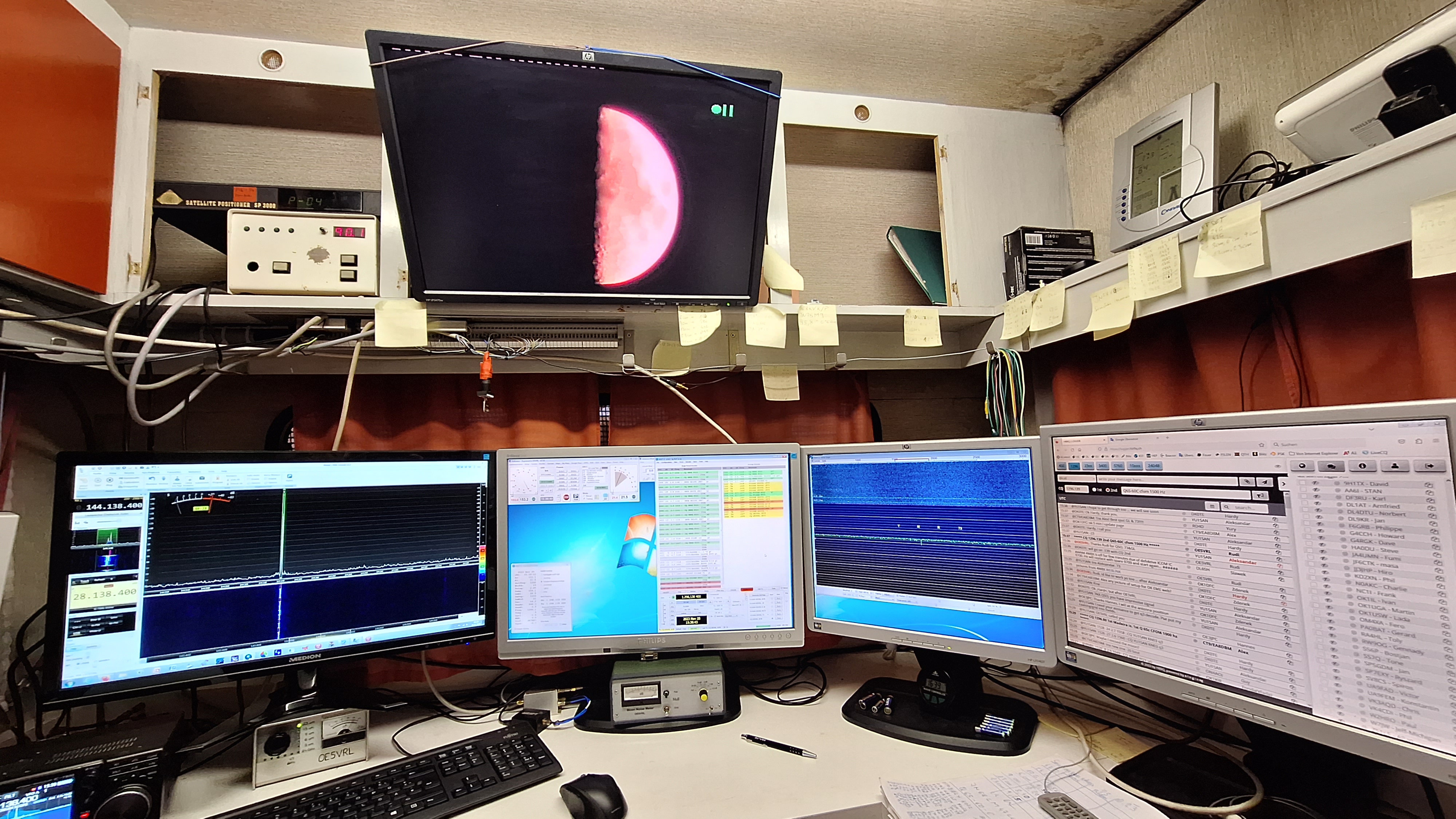 OE5VRL shack
OE5VRL shack
 OE5VRL 3 m EME dish
OE5VRL 3 m EME dish
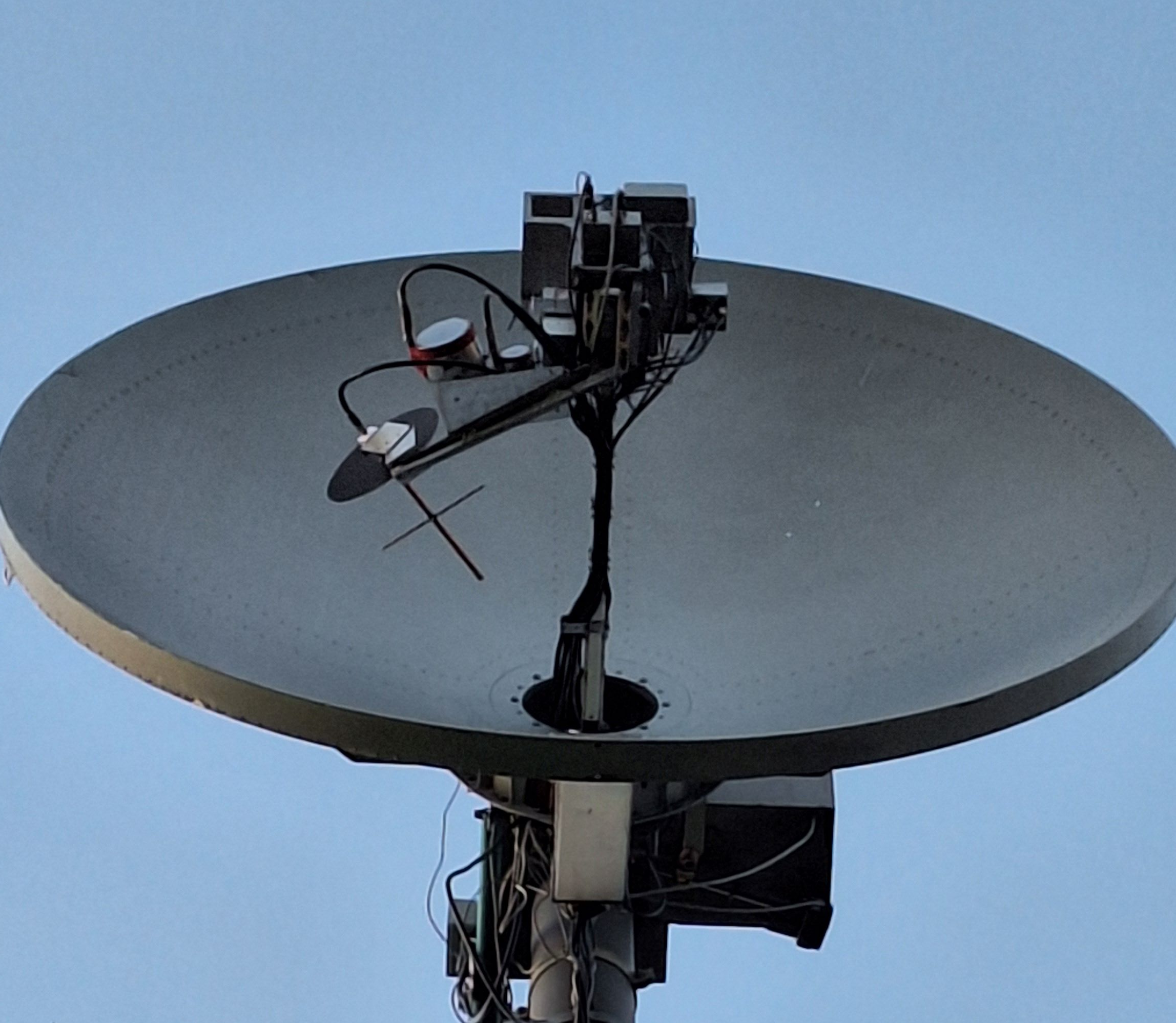 OE5VRL Closeup of 3 m dish
OE5VRL Closeup of 3 m dish
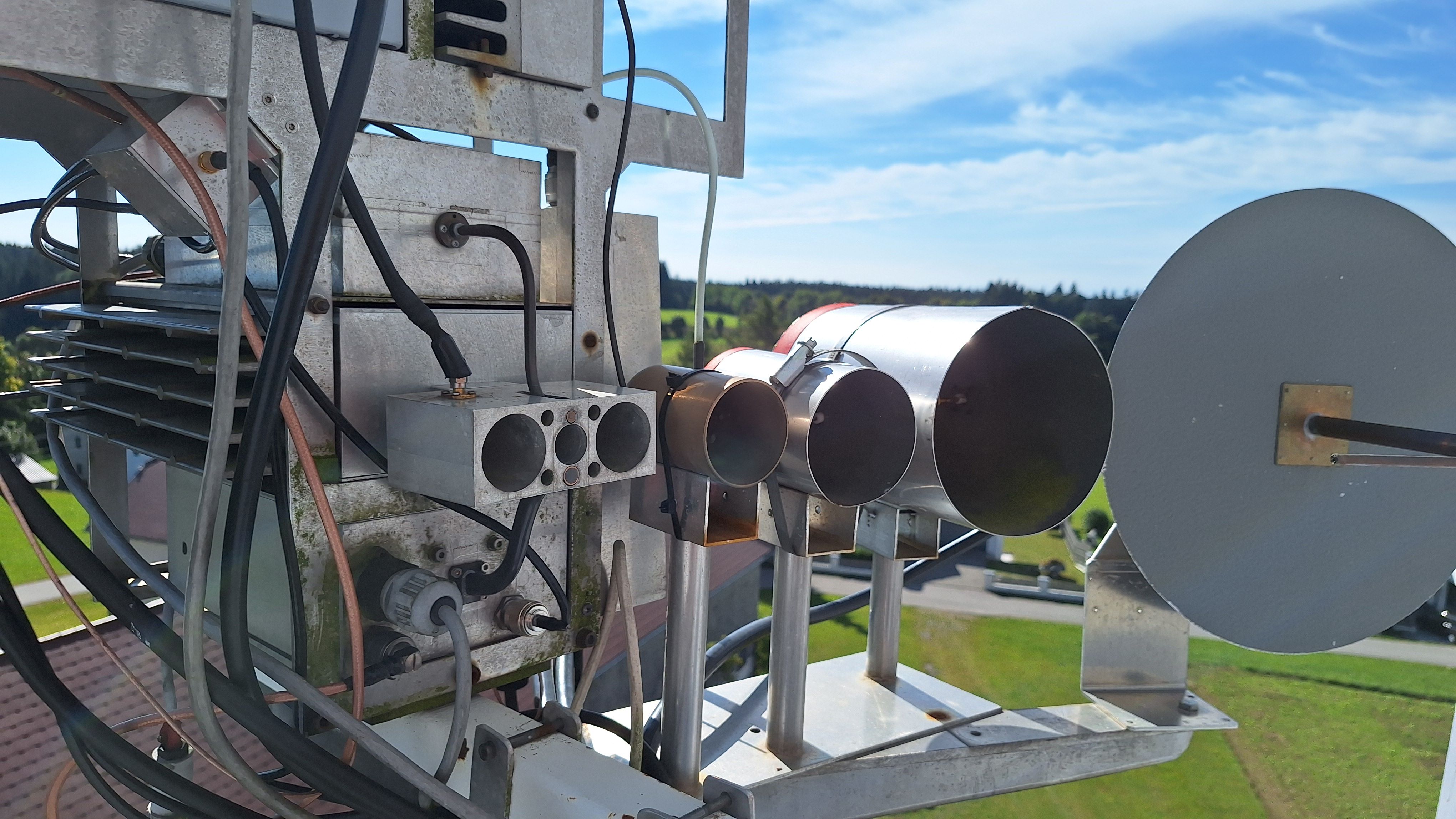 OE5VRL Feedhorns and Equipment
OE5VRL Feedhorns and Equipment
OH3LWP Ari
I was travelling during the ARRL eme contest 4th weekend and arrived home just before the contest end at 23:00 UTC on Sunday. I was surprised to see a lot of stations still active and worked the following on 1.3 GHz: 9/11/2025 digital ON4BCV, 8Q7UM, LA3PNA, SP0KKM, F5JWF, DF2VJ, OZ5TG. This brings my total at 1.3 GHz from weekends 3 and 4 to 102 QSOs.
My ARRL eme contest 2025 single operator, multiband summary is as below:
1296 MHz - 5 CW - total 102 QSOs
2320 MHz - 5 CW - total 27 QSOs
3400 MHz - 0 CW - total 3 QSOs
5760 MHz - 1 CW - total 11 QSOs
10368 MHz - 0 CW - total 46 QSOs
Total 189 QSOs, Raw Score 3,213,000
Outside ARRL EME contest highlights were nice initial QSOs and 3 new DXCC:
31/10/2025 3 cm digital BD4SY (also a new DXCC!), 6 cm digital OE5VRL, 9 cm digital OE5VRL
02/11/2025 3 cm digital BA7NQ
03/11/2025 3 cm digital IZ0JNY
04/11/2025 23 cm digital 8Q7UM (thank you Alex for a new DXCC!)
06/11/2025 23 cm digital BG0DXC
13/11/2025 9 cm digital PA0PLY
15/11/2025 9 cm digital OZ5G (also a new DXCC!), 23 cm digital DJ3JJ
16/11/2025 3 cm digital IK3HAR (Claudios first 3 cm eme QSO!), 23 cm digital F1PDX
I would also like to mention that I worked 5 bands with OE5VRL in 40 minutes on 31/10/2025 3 cm 16:23, 13 cm 16:37, 6 cm 16:47, 9 cm 16:55, 23 cm 17:03. Thank you to Rudi for my first 5 bands set of eme QSOs in one go!
OK1DFC Zdenek
ARRL EME 2nd leg 432 – 1296 MHz
I didn't prepare for the last part of the ARRL EME contest in any special way. I just installed the new WSJT-X 3.0.0 to try it out. Unfortunately, I couldn’t complete the installation of the 144 MHz band. Last round, I was QRV on 23 cm, so I chose the 432 MHz band for the first half of the weekend and the 23 cm band again for the second half. Activity of 70 cm seemed very low to me. In the CW band, I found only three stations that could be worked in CW. The rest, i.e. 58 QSOs, were made using Q65-60. Working in the 432 MHz band also brought new initials, so I finally got past #600. More information about initial QSOs at the end of the post.
Nevertheless, these connections earned me enough points in the Multi-band - Single Operator category. After switching to the 1296 MHz band, I worked with 46 more stations bringing my final total to 189 QSOs in this band. Most of the QSOs were made using Q65-30B. This mode significantly sped up digital QSOs, and only very weak stations still used Q65-60C. Overall, I was pleased with the high participation of stations from the USA. Umbrella antennas are growing like mushrooms after rain, and the currently very popular Chinese 180 cm parabolic antennas made from solar heaters are also becoming very popular, which promises increased activity in the future. In total, I manufactured and delivered 150 light-weight feeds, and many stations also sent me information about how their reception had improved and how they were getting better reports.
The participation of OK stations was very good.
In the 432 MHz band, OK1VUM was again in charge, and OK1IN was also new. OK1TEH appeared, and I also made several connections. OK1KIR was not present this time due to a malfunction of the 432 MHz equipment. Participation in the 1296 MHz band was even higher. The participation of OK stations was very good as OK2AQ, OK2PE, OK2DL, OK1IL, OK1KIR, OK1IPV, OK1DFC were all active. The weather during the second round was not very pleasant. It rained and was foggy where I was during the contest.
This contest marked the end of the 2025 EME competition season. We can look forward to the 2026 season. Thank you all for calling, and I look forward to hearing from you again sometime via the Moon.
My final contest score was 10, 307, 600.
47 – 76 GHz
I have now returned to the 47 GHz band. I have made some further minor adjustments and thanks to Mirek OK2AQ I have also taken precise measurements of the power delivered by the SSPA. I now have 50 W of power available at 47 GHz and am looking forward to trying for QSOs when the weather and time allow. The last windows in September and October saw very bad weather at my QTH, with rain, fog, and strong winds. Unfortunately, the attempt to make a QSO with Miguel CT1BYM did not work out. I couldn't hear the noise of the moon at all with the noise produced by the rain. I was just a little bit unlucky.
I have also made progress with the 76 GHz band, where I have a 3.8 dB N/F LNA and can listen to a very strong and stable signal in the 76 GHz band from my beacon in the lab. Unfortunately, the power of the transverter is very low, only 180 mW. I am currently also working on the mechanical part of the 76 GHz transverter so that I can easily install it in the dish. Manfred DL7YC and Sergey RW3BP, who are also very well equipped for 47 GHz, currently have 76 GHz bands installed and are conducting experiments on this band during suitable windows.
Table of initial QSOs.
432 MHz
DF6LH JO30KN -19 -12 #585, W3TI FN20FM -10 -22 #586, N1AV DM43FG -9 -12 #587, DC1RDB JN58SS -12 -32 #588, K3WM FN00EN -18 -17 #589, VE3CIQ FN15WC -21 -25 #590, S57Q JN76PA 2 -14 #591, OM3TRN JN98JN -1 -9 #592, DD0VF JO61TB -20 -22 #593, F6DRO JN03SM -6 -17 #594, OH1LRY KP11FA -1 -11 #595, PC0A JO32IE -10 -9 #596, SQ2SAT JO83XG -18 -14 #597, G0JLO IO81WM 449 449 #201 - CW, JA4MVG PM74AP -10 -15 #598, BG7XWF PN11 -12, -21 #599, BD2QAX PN11 -15 -22 #600, JG2XWH PM94LX -14 -17 #601, BY1QH ON80DA -17 -20 #602
1296 MHz
8Q7UM MJ63 -16 -16 #672, K5SE JO53IN -12 -13 #673, K1DS FN44 -11 -9 #674, K4UGO EL96VH -21 -11 #675, W1VK FM17PG -13 -18 #676, N0LWF EN10WM 3 -6 #677, DL8MAI JN57FV -3 -11 #678, W4UNU EL98GI -1 -12 #679, F5AOL JN38HD -7 -10 #680, PE1ITR JO21QK -19 -22 #681, OZ3Z JO45UN -7 -10 #682, BY1BY OM89 -8 -2 #683, F5JWF JN26 579 599 #513 -CW
 OK1DFC Band Scores
OK1DFC Band Scores
 OK1DFC Station Worked Geo Spread
OK1DFC Station Worked Geo Spread
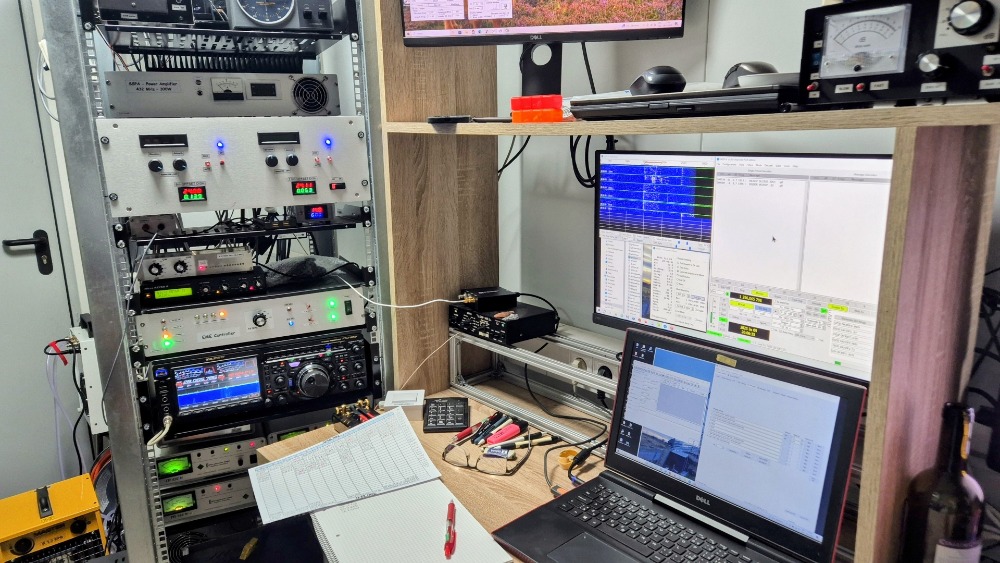 OK1DFC Hamshack
OK1DFC Hamshack
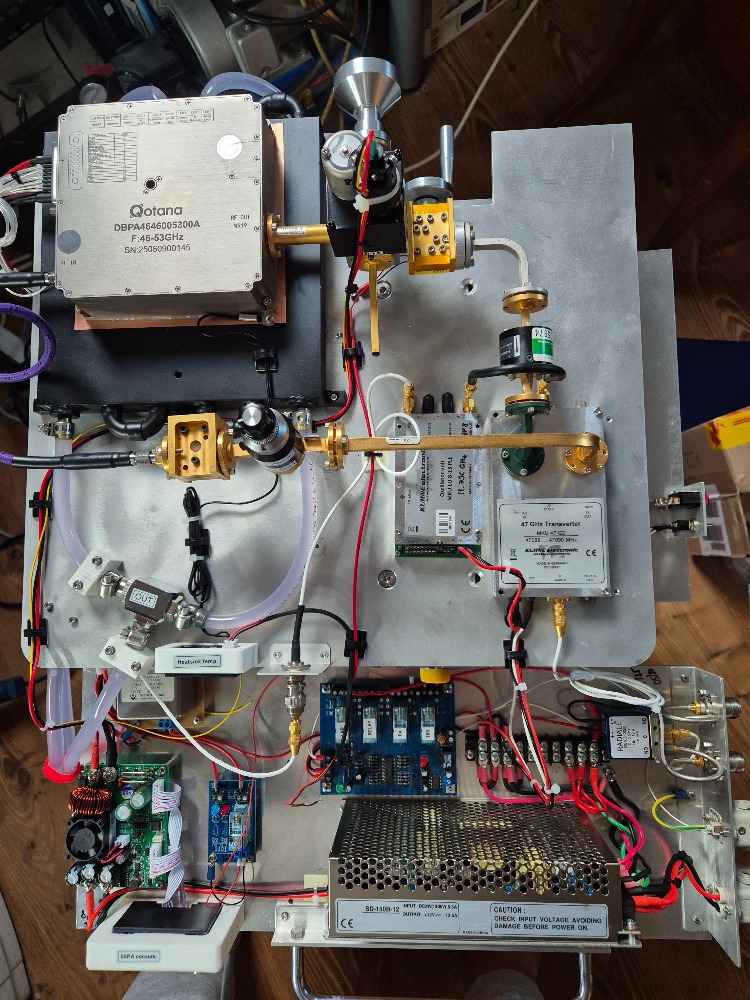 OK1DFC 47 GHz Rig
OK1DFC 47 GHz Rig
OK1KIR Vlada
We spent the last three weeks of October and the first week of November rebuilding the dish steering system. We replaced the F1EHN tracking system, which had served us well for more than 20 years, with the HB9DRI Antrack-Pro system. The change was associated with complete revision of all parts of the steering mechanism including electric parts and circuits. It was quite demanding work that required more time and effort than we expected, but we managed to complete it all just before the last part of the ARRL EME Contest.
During final testing on Nov 5th at 19:35 we made a QSO on 24 GHz with IZ2DJP -17 (B-15) / -11 dB and measured at MN 2.9 dB. On the next day, Nov 6th at 18:54 we QSOed OZ1LPR with a huge 0 dB signal (Peter announced 175 W TWTA output power!) while we received a -10 dB report from him. Later our own echo gave a SNR of -8.0 dB and total width ≈120 Hz. That corresponds to the ratio of the HPBW of a 4.5 m dish and the Moon’s solid angle and predicted spread width of ≈300 Hz.
After the 24 GHz tests we switched to 23 cm to catch the 8Q7UM expedition. First we worked with Q65-60C on Nov 6th at 20:26 F5AOL #650, 20:48 SO5AZ #651, 21:26 ON4BCB #652 and finally at 23:19 8Q7UM #653. Further on we added at 23:40 GW4ZHI and on Nov 8th with Q65-30B at 18:22 OK2DL, 18:51 OK1KKD, 19:21 SP0KKM #654 and with Q65-60C at 20:40 OZ2ND #655. On the morning of Nov 9th we added using Q65-60C W2MMD #656 at 04:01 and with Q65-30B at 04:43 K4UGO #657.
With CW we worked only on Nov 7th at 00:01 8Q7UM 539/539 as #530, DXCC 91 on CW and new field MJ, on Nov 8th at 19:55 PI9RD 599/599 and on Nov 9th at 00:37 SP0KMM O/O as #531.
On the morning of Nov 9th we switched to 70 cm but did not operate as Moonset came earlier than we expected after we repaired a hidden failure.
On Nov 23rd 2025 we at OK1KIR will remember the 50th anniversary of the 1st ever trial in OK land to make CW EME QSO on 70 cm. 50 years ago we were receiving WA6LET 539, but one dot was swallowed by the fading and it created from callsign OK1KIR a US station K1KFO and unfortunately guys at WA6LET only recognized that later from a tape record. However, they did send us a nice QSL card for the RX report.
OK1VUM Mila
There was a strong wind blowing before the contest, so I decided to lower the antenna to the ground and use the opportunity to perform some maintenance. I adjusted the clearance in the azimuth rotor and replaced the bearings in the antenna lowering mechanism. The second part of the 70 cm ARRL contest 2025 was again held at night, which is not ideal for me because I like to sleep at night. After the first part, I expected a worse final result than last year, and in the end it was, but not by much. The reason for it was the lower participation, and there was nothing to do for long periods of time.
This year's 70 cm ARRL contest brought me a total of 13 initial contacts: XQ3SA, YO2NAA, BH2RSJ, F6DRO, BA7LVG, BG7XWF, OK1TEH, W3TI, DJ7FJ, 4X1AJ, SQ2SAT, DF2VJ, and RU4HU. There weren't many stations on CW, as the contest conditions don't motivate anyone to use it, so I made CW QSO with three stations that were exclusively on CW, namely DL9KR, SM2CEW, G3LTF, and with three other stations, OK1IN, PC0A, and UA3PTW, which I had already logged in digital mode, but I made CW QSOs just for fun.
I was intrigued that the station BG2RSJ was logged into the chat, while I had the station BH2RSJ in my log. By asking in the chat, I found out that the person in question had lost their chat password and solved it this way :-). What I didn't understand was BI6DX. I easily decoded several periods, while he wrote to me on chat that he could see me well but couldn't decode. I couldn't figure out the cause; it's possible that he had something set up incorrectly.
On Sunday morning, I hardly transmitted at all because the OKOMDX contest was going on at the same time, and when transmitting on 21 MHz, my azimuth and elevation measurements didn't work because the antennas are right next to each other and the RF energy from 21 MHz caused false measurements from the sensors.
My contest result has a total of 105 QSOs, including 3 CW, and the rest with Q65-60B, with 89 multipliers, and a final score of 934,500 points.
PA0PLY Jan
After being QRV on 23 cm the October ARRL weekend, I changed to 70 cm for November. I use a 3 m dish, a feed with polarisation adjustment and approximately 300-400 Watt of RF power.
After installation I tested and all looked fine, except the adjustable polarisation rotor did not work. After some investigation I could only do a repair when all was on the bench again. Knowing that the vertical polarity is worse than horizontal polarisation I decided to stay horizontal only during the weekend. Due to a high level of local noise during Moon rise, I decided to start the contest after AZ 180 degr, meaning I could only work in my western window.
Rather than calling CQ all the time I hunted for new initials and it worked out. I made a total of 21 QSOs with 11 initials.
New were: S57Q (-18/-22), VE6TA (-20/-19), OK1IN (-25/-32), DF6LH (-22/-26), OM4EX (-20/-23), DC1RDB (-26/-26), SM4GGC (-22/-21), PC0A (-25/-19), N0AKC (-27/-30), OH3AWW (-24/-29), OH1LRY (-21/-15)
All reports were in the -2x dB, with a few exceptions. Picking up weak signals in the middle of all those birdies was a real challenge.
Tried with K5N many times but all failed. Also with Barry VE4MA we spent a long time without success. I copied Barry very steadily at -26, but he never got my signal seen on the screen.
After the contest I installed my new system for 3400 Mhz based on SG-lab transverter, DU3T SSSPA 100 W and G4DDK preamp.
On Nov 13th I QSOed OH3LWP for #24.
On Nov 15th I QSOed OZ5TG
Let me remind everyone of the planned 13cm Activity EVENT on December 6th and 7th, 2025. Those moonpasses have good windows to the east as well as to the west. I have received commitments from the following stations to be active: BA7NQ, DU3T, G3LTF, G4CCH, JA6XED (cw only), JJ1NNJ (cw only), KL6M, KN2K, N1AV, N0AKC, OH3LWP, OK1DFC, PA3DZL, PA3EXV, PE1CKK, PE9GHZ/PI4Z, PI9RD (probably only one moonpass), VE4MA ,VE6BGT, ZS6JON (Working hard to get his dish up. Fingers crossed he can give us African continent.).
PA0TBR Ton
This month saw another trip by Alex, EA8DBM, this time as 8Q7UM which gave me a new DXCC from the Maldives. Alex was very active before and during the contest with a very nice signal and excellent reception. Thank you again Alex.
The 2nd leg of the ARRL contest on 1296 MHz was again great fun. It brought me another 51 QSOs, 34 new contest grids and 23 initials. The total for the 2 legs is 132 QSOs, 110 grids and 43 initials, all with Q65.
I didn’t expect new entities during the 2nd leg but was more than happy to work SV3AAF who gave me a fast confirmation for Greece via LOTW.
Overall it was most enjoyable to contact so many stations, old and new.
PA3DZL Jac
During the ARRL contest I was QRV with my Double Quad antenna and about 110 W (there was a photo in the last NL). I was very happy to have 3 QSO's with:
1. DL0SHF (9 m) -18 / R-26 INITIAL #5
2. K0PRT (18.3 m) - 25 / R-21 INITIAL #6
3. OE9ERC (10 m Offset) R-23 / -23 INITIAL #7
Up to now I have made 9 QSOs and 7 Initials with this very small antenna. Howard G4CCH did decode me with his 5.4 m dish, no QSO yet!
See the photo of the QSO with DLØSHF, a very nice signal in the waterfall.
Further Activity report from October 30th up to November 9th:
PA3DZL on 432 MHz made 27 QSOs and INITIALS were DDØVF, BG2QAX, DJ7FJ, BY1QH, F6DRO, BH2RSJ and GMØICF for a total of 452 initials mixed CW/SSB/Digi.
PA3DZL on 1296 MHz made 55 QSOs and INITIALS were F5AOL, ON4BCB, 8Q7UM for DXCC #121, N4BAA, DL1HUH, W1FKF, W4UNU, WA3GFZ and W8TN for a total of 691 initials mixed CW/SSB/Digi.
I was also QRV on 144 MHz and made 47 QSOs, 19 Initials and 3 new DXCCs.
ARRL EME Contest two weekends:
Due to QRL and Family commitments I could only be QRV for a limited time. I had great fun and made 147 QSOs on 144, 432, 1296 and 2320 MHz.
On 1296 MHz I used Mode 15A which is very nice, and made 17 QSOs in a very short time using 30B and 23 QSOs in CW.
On 432MHz I used Mode 30B and this worked great also, 6 QSOs in a very short time, only a few CW QSOs this time.
On November 6th i had a visitor in my shack, no ham but graduated from the University in RF-engineering. I was doing some echo tests on 1296 MHz, also in SSB and managed to QSO in SSB with SV3AAF, DF3RU and ON4BCB. He found this incredibly cool and was very impressed by the signals bouncing off the MOON. In his laboratory at QRL, he works on projects above 40 GHz ... very interesting!
 PA3DZL QRP QSO with DL0SHF
PA3DZL QRP QSO with DL0SHF
PJ4MM Martin
This year I only participated in the November ARRL contest weekend, and I spent time on both 222 MHz and 432 MHz. It was the first test for my newly added vertical yagis for 432. I am very glad I added these 4x12 el M2 to my setup, I think I used them for RX with 70% of my QSOs, and also a few on both RX and TX. It looked like there was a serious polarization change on my RX for the whole weekend.
The end result was a bit disappointing 5 QSOs on 222 and 32 QSOs on 432 with 2 new DXCCs and a few new grids on 432. My RAW-SCORE according to the ARRL is 129500.
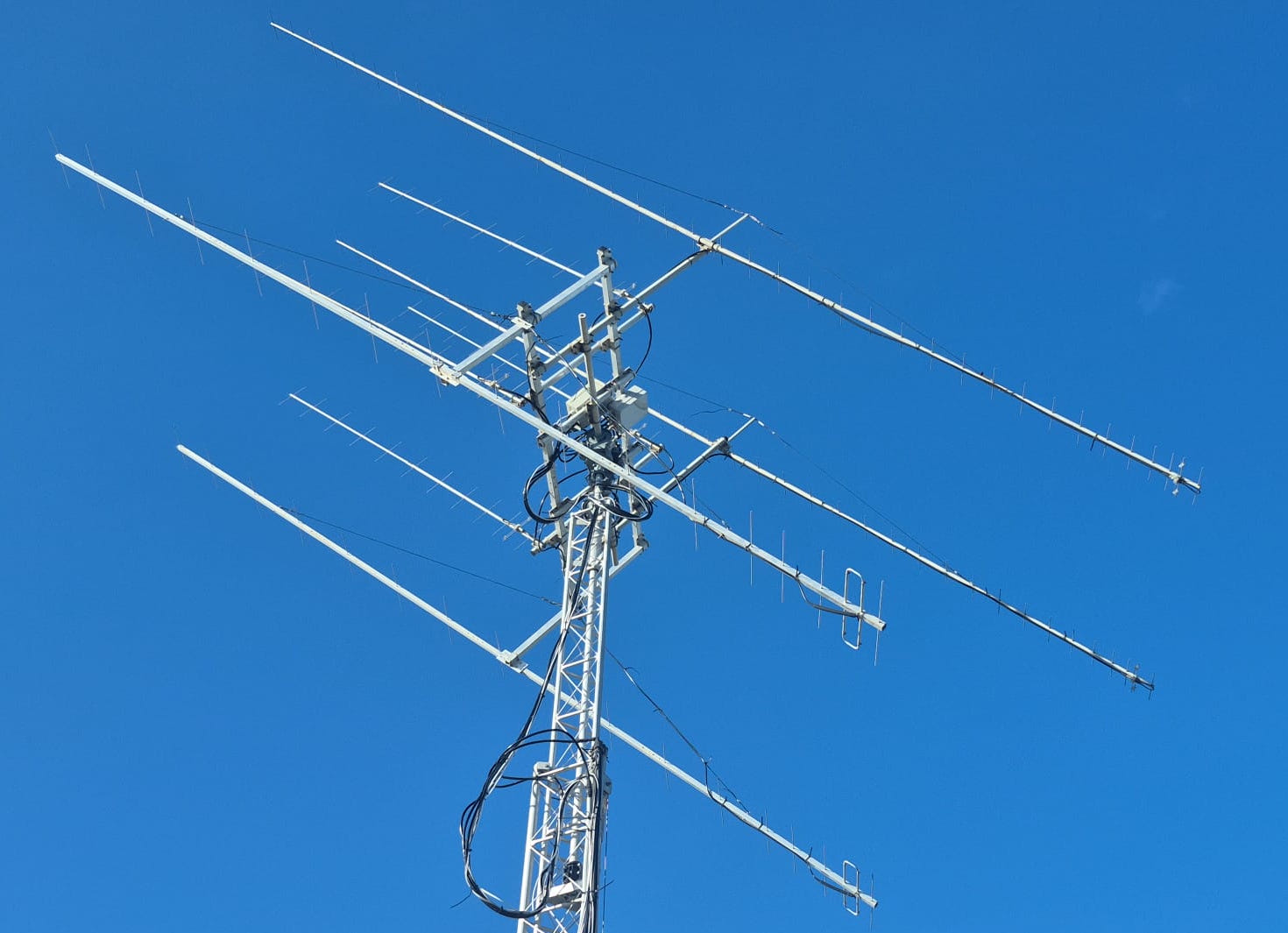 PJ4MM 222 432 fall 2025
PJ4MM 222 432 fall 2025
SM3BYA Gudmund
Just to let the gang know that I haven’t gone QRT: this summer has been crazy, no time for radio. My 1296 system has been unusable since the May VK3UM memorial, when one of the leads to the LNA protection relay coil worked loose as I turned the antenna and the LNA blew out when the relay didn’t pull in. I only found time to repair it the week before the ARRL 2nd weekend. I didn’t want to risk another mishap with the T/R switching with winter around the corner, so instead I spent a total of four hours SWLing the CW segment. Result: 32 stations copied: 22 old friends (the usual suspects) plus 10 that would have been new initials: DL1HUH, NQ7B, W2ZQ, ES3RF, SP3YDE, JH5LUZ, DL7UDA, IK5VLS, IQ2DB, F6ETI.
Great to find so many new CW signals on the band. I may be back in December if I can get the TX chain to play and hope to QSO some of the above then. At least I won’t have to worry about a non-working protection relay - after the contest I put a current sensor in the relay circuit that closes the main TX interlock chain only when the current is within a window of (-20% … +30%) of nominal coil current. I should have done that long ago. I can provide a schematic by email if someone is interested.
Work on 5.7 GHz gear in progress, but slow…
SM4GGC Stig
A Fun contest!
I was on 70 cm as a single operator. I did not spend any night hours this year and was only active until 23.00 and started in the mornings from around 06.00 local time.
New stations and DXCCs were worked and I was glad to see a couple of new Chinese stations.
In the second weekend I had some trouble with my elevation control caused by RF when I was transmitting. I had to do some work with ferrites on the cabling at the rotator, so I lost all time on Saturday morning of the second weekend.
My result: 1 CW + 74 digital QSOs with a Raw Score of 472,500 this year
Rig: Antenna 6X26 YU1CF yagis with about 400 W in antenna, QMAP and WSJT-X 3.0.0 improved PLUS edition
SP2WRH Rafal
I had an unforgettable contest day. First, my early morning flight back from work was cancelled, and the only available one was landing in Gdańsk just two hours before the contest started, hihi. I was worried that some technical issues might appear, because the 70 cm system hadn’t been used for more than two months. Fortunately, everything worked flawlessly, which made me very happy.
I operated exclusively on the 70 cm band. In total, I made 57 QSOs (score 253,000) in Q65B mode, including two duplicated contacts. A few QSOs were particularly interesting for me: contacts with UD2F (150 W and a 26-element Yagi), DD0VF (60 W and 4× 9-element Yagis), and JG2XWH (50 W and 4× 22-element Yagis). It was the first time I worked stations using QRP.
My system is a home-made 8×27-element horizontal-polarization DK7ZB Yagi with a DF9IC match.
I would like to say thanks for the good fun.
VE4MA Barry
I had planned to be on 432 MHz on the first pass in November and on 902 MHz for the second pass. There was a big Aurora event on Saturday and since I am in the Auroral zone... I seemed to be suffering some absorption on RX, but other stations seemed to be hearing my 300 W into a 3 m dish with polarity switching. I thought it may have been an RX problem... so I removed my T/R relay and preamps and they tested OK on the workbench. The sun is too low to check on my polar mounted dish.
I continued to operate and on November 8th and QSOed OK1DFC -24 / -19. UA3PTW -20 both, K4EME -22 / -17 , N1AV who heard me steadily, but I struggled with -32 (best -28) / -21, and K5N -23 /-21. At about 05:47 I noted some very deep and rapid QSB on signals in the panadapter. Signals that were 15 dB/ N would fade to the noise in a few seconds.
On November 9 we had high winds and light snow and I decided to remain on 432, rather than change feeds to 902 MHz in the dark. At 04:20 I saw NC1I with only a -19 signal. Last month I had QSO'd Frank -13 (-11 best) / -13. On monitoring for a few minutes his best was only -16. According to the chatter on HB9Q there were a lot of stations QRV that I should have been able to copy... but nothing was seen in any polarity. The Aurora of the previous night was gone... so?? I went QRT at about 06:00.
I have found nothing to explain why I was hearing so poorly. My RX preamps have a SAW filter after the high dynamic range first stage. My PY2BS patch feed is mounted for an SWR minimum at 1.5 WL (105 cm) from the dish surface... the focus is at 1.3 WL (91 cm) so the feed was mounted beyond the focus and over illuminating the dish. Possibly with the spillover I was picking up more noise (433.9 WX stations?) than in the previous month. I am going to install a metal screen "fence" around the perimeter of the dish similar to what KB2SA is using on his 1.0 m dish.
VE4SA Shawn
After attempting my first 10 GHz EME activity with only one successful decode of OZLPR (Q65 60D @ -4db) on the September 13/14 contest weekend, and again on the first night of the October 11/12 weekend, I focused on 23 cm for the remaining contest.
With the winds gusting to over 60 km/hr I did not risk 23 cm operation of the 3.7 m dish on the second night in October. All activity for this contest was limited to the November 8/9 weekend. Both evenings we had excellent WX for this time of year, and after freeing a frozen actuator, I had excellent operating conditions.
The OZ9CR six tube amplifier kept the shack warm, working a total 52 stations, all with Q65, except for one CW QSO with G4CCH to close the contest. Fifteen initials were made with UA4AAV, DK3EE, N4BAA, DL4DTU, I2FAK, RA2FAG, W4UNU, F5KSE, PA3EXV, SM6PGP, DL1SUZ, PE1CKK, SO5AZ, W8TN, and ZS5Y who is my first African EME contact. Overall it was a fun weekend of activity. I hope to be active on both 3 cm and 23 cm for the 2026 ARRL International EME contest!
VE6BGT Skip
I was able to get onto 23 cm for the ARRL contest event. I don't really contest but just like to get on and make some noise for a few contacts and check the system out. I had just changed the water on my amplifier system a few days before and had echo tested things off the moon to be sure everything was 100 percent or as close as it could be.
On the first night I fired things up and of course that's when things happen! My main computer that tracks the moon for the dish and monitors all the action with various VB programs decided to act up. It came up and then as soon as I started programs it would crash and restart. I have been doing some work on this computer and building up backup machines. So I had done some RAM changing and suspected that was the problem so I yanked the new memory RAM card and it then died completely. So I pulled it out of the rack and slid in the backup machine that I had just built. It came on and gave me a few serial port issues that a restart cured. All was good.
So I finally got on transmitting and worked the following stations on the first pass: SP6JLW 589, I2FAK 579, DF3RU 579, K0PRT 55 (SSB), W2ZQ 569, G3LTF 589, WA6PY 579, IK2DDR 589, PA3DZL 589, DL3DTU 579, F5KUG 569.
Then on the second pass: SP3XBO 579, KL6M 589, SP9VFD 589, OK1DFC 599, LZ2US 589, YL2GD 569, SM2CEW 589, G4CCH 599. Signals were quite good but I noticed some real deep and slow fades. A signal would be 589 and then slowly fade into the noise to return slowly to 589. This was during the Solar storm event.
It was all fun once again. Sorry for those who wanted to work me with WSJT but I just don't have things set up for the digital modes.
 VE6BGT Dish
VE6BGT Dish
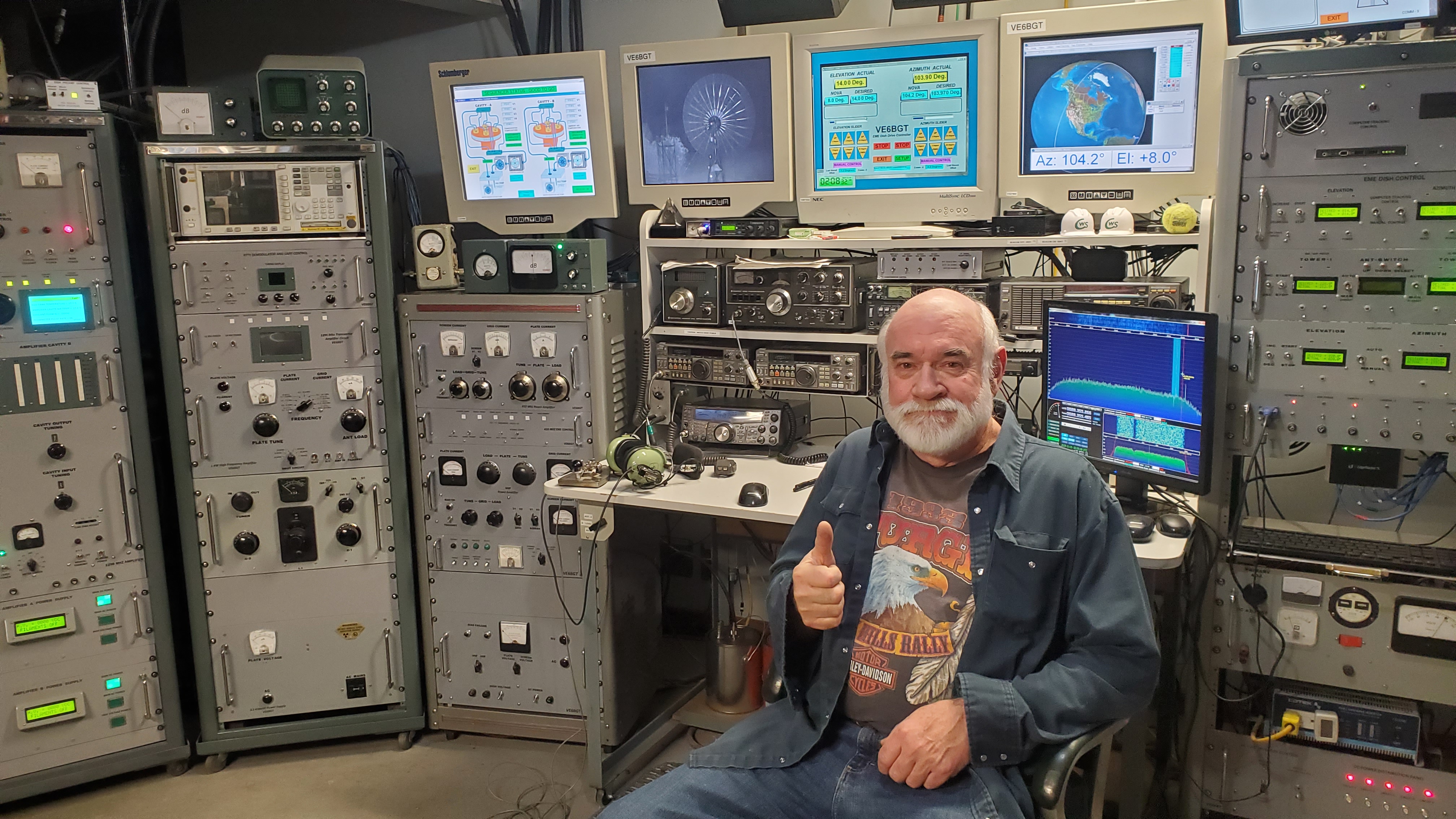 VE6BGT in Shack
VE6BGT in Shack
VE6TA Grant
I changed feeds over to 432 this month in preparation for the ARRL contest. I had upgraded my 432 dual dipole feed mechanically with a better mechanical back support, and had to rewire the HV for my GS23b 432 amp after some shack renovations.
I was able to get on 432 the week prior to the EME contest and worked the following two initials: # IZ3ATX, and # W4HFZ with his two small yagis in Alabama.
On November 7th we received a fair amount of freezing rain and I had to try and de-ice the 5.5 m dish prior to getting on for the contest. The freezing rain is pretty unusual for us in the northern prairies here. Usually we zip right through to blizzards but not this year.
On Nov 8 I started off after a few degrees of elevation and heard strong signals. Most stations worked cross polarized, i.e. TX 90 degrees off from the strongest RX polarity, so my polarity rotor got a workout. Most signals were not smeared and once the polarity was determined they were booming from the speaker.
I worked on Q65: # SP2WRH, ON7EQ, # PJ4MM (Bonaire), KD2LGX, DL1VPL, OM4EX, # DJ7FJ, K4EME, DC1RDB, # W3TI, # OK1IN, # PA0PLY, K5N, WD5AGO (CW with a fair bit of QSB,) Q65: N1AV, OE3JPC, W7TZ, UA3PTW, OK1VUM, OK1TEH single yagi, S57Q, SM4GGC, # K7ATN single yagi 110 W, W4ZST, # K3WM, GM8JBJ, G4RGK, IZ3ATX, VK2CMP, # BY1QH, # BG7XWF. It was quite a thrill having K7ATN call me on random for a new initial with his 110 w and single yagi.
I am now at 322 mixed initials on 432. Good to see so many new stations on the band.
On Nov 9 I changed the feed and reconfigured the shack for a 222 MHz EME session. I had converted a Henry 3002 amplifier to 222 and wanted to give it a good test this year. Stations worked on Q65 were: K5N, N1AV, W7JW, PJ4MM, W6TCP, K3SK, # AA4ZZ in NC with a single yagi and W7TZ. This brings me to 38 EME initials on this band.
I also worked a few 144 MHz EME QSOs on JT65 using 300 W and my roof mounted yagi. Stations worked were; OK1DIX, W9IP, S51ZO.
So with all 4 weekends considered I was able to activate 6 EME bands this year with a mix of CW and digital QSOs from DO33gs.
144 - 4 QSOs - 300 w 17 element fixed on horizon yagi
222 - 8 QSOs - 1 kw 5.5 meter HB mesh dish with polarity rotation
432 - 31 QSOs - 1 kw 5.5 meter HB mesh dish with polarity rotation
1296 - 46 QSOs - 600 w 5.5 meter HB mesh dish with screw polarizer CP feed
2304 - 18 QSOs - 350 w 5.5 meter HB mesh dish with septum polarizer CP feed
10 GHZ - 17 QSOs - 30 w 5.5 meter HB mesh dish with linear feed and manual polarity adjustment.
Total of 124 QSOs. Not sure of the grid multipliers but I most likely will not enter my score.
VK2CMP Mick
I completed my portable 23 cm station just a few days before the contest weekend. Due to bad WX it was hard to conduct a test but finally the rain stopped and winds slowed in time for me to make my 1st 3 QSOs around midnight on the Tuesday before the contest. I did plan on further exercising of the setup before the weekend but the rain and wind returned. Amazingly on the day of the contest the sun appeared and I put the folding dish back out in the front driveway and used I0NAAs TotalPower and a RTL V4 SDR to measure the sun noise to optimise the placement of the Septum feed as well as dish pointing.
When you step back from the mad rush and countless hours building a new capability it’s nice to take a moment and appreciate the Hams that make it so easy to build such a high quality 23 cm portable station in your own workshop. Its pretty cool to have the collective wisdom of W2HRO (folding dish), WD5AGO (LNA), W6PQL (PA), HB9DRI (AnTrack Pro), OK1DFC (Septum), K1JT et al (WSJT-X) sitting in the front driveway!
So the decision was made to get maximum fun for this contest and operate 70 cm from the shack and 23 cm from the driveway hoping that no passers by in the middle of the night would flog my new laptop! It certainly proved to be a way to meet people having a 2.4 m folding dish in your front drive. So many people dropped by for a chat. The plan is to use the setup portable as I do not have a location for the dish at the home QTH. We tend to do a couple of 10 or 12,000 km road trips each year in the 4WD so plenty of time in the future hopefully.
I operated 23 cm for about 4 hours on Saturday night and made 15 QSOs. I was very happy with the performance, especially since my neighbours fence partially blocked me early in the evening. I ran 300 W and had a fair amount of local QRM that was easily audible on the speaker and I was amazed that I could still decode during some of this noise. Tommy AGO made me a 2nd LNA with plenty of filtering for home QTH use in our local 23 cm activity days but in a brain fade I had the other LNA for portable use in the feed. I did plan to swap over to this LNA for Sunday as there were some stations that I felt I should have been able to copy better but alas my LV supply failed in the PA so I just concentrated on 70 cm for Sunday.
The highlight of my 70 cm ops was working two new DXCC being Martin PJ4MM and China not once but 4 times in BG2QAX, BG7XWF, BH2RSJ & BY1QH. I also had three other initials OM3TRN, OH1LRY and OH3KLT. So the goal was achieved - great fun was had and I’m now I’m planning on adding 2.4 GHz so I can operate another band next year
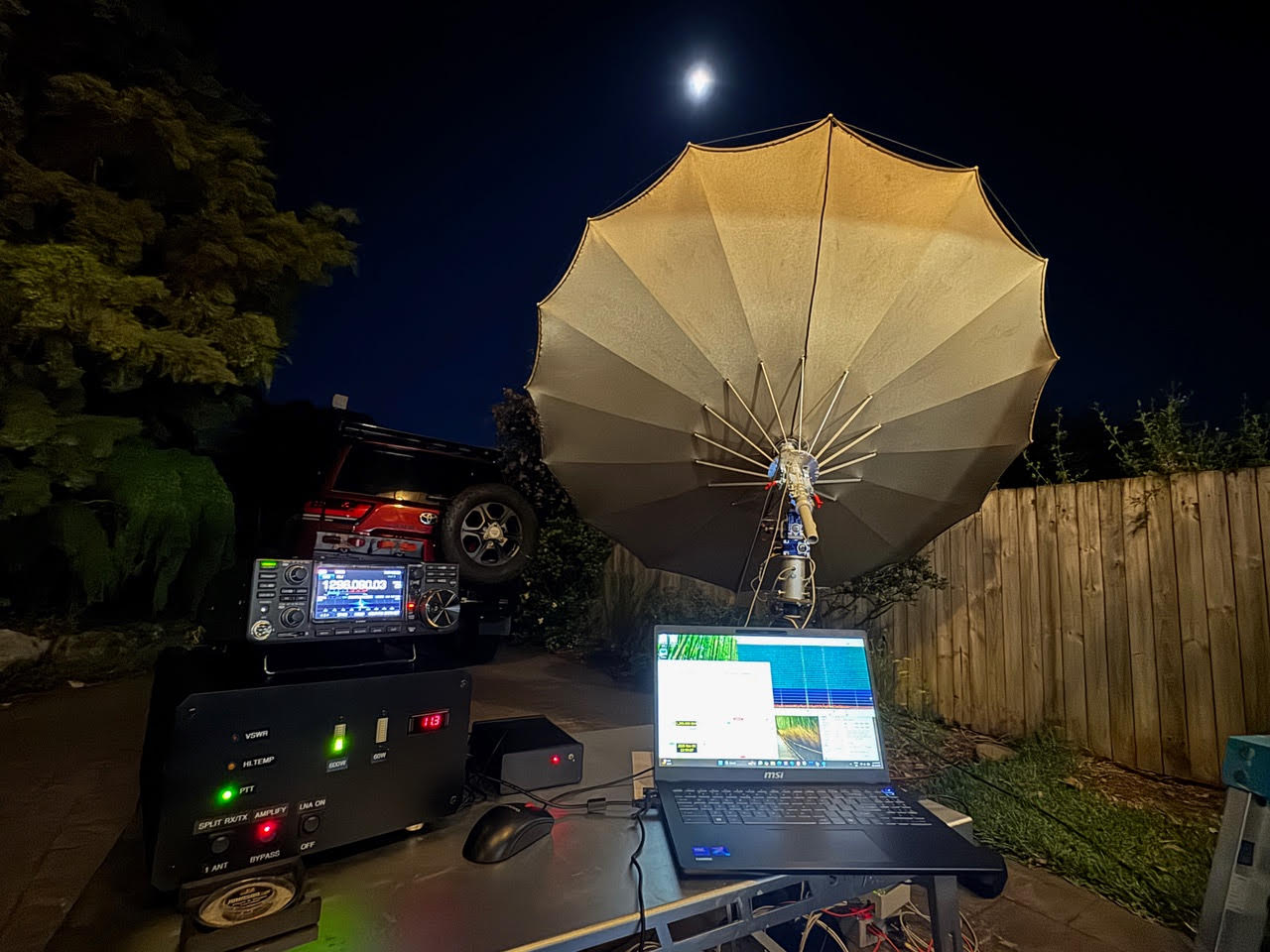 VK2CMP Driveway Setup
VK2CMP Driveway Setup
VK7ZBX Richard
I thought I would drop a short note to let you know of the activity here in VK7.
No activity in the ARRL contest sadly due to work commitments but I did manage to work a new initial on 3 cm. Terry BA7NQ in China. Great signals S-16/R-18
That makes a total of 65 initials, and so far 30 DXCC entities worked with 21 confirmed. A long way to go but getting there.
My 3 cm system is a 1.8 M prime focus dish made by Mitec with a WR75 shepherd's crook feed. Kuhne G4 transverter, 20 W SSPA and waveguide LNA, IF radio is an Icom IC9700 and tracking is a RazTrak from Gary N8CQ.
73 to all from Hobart
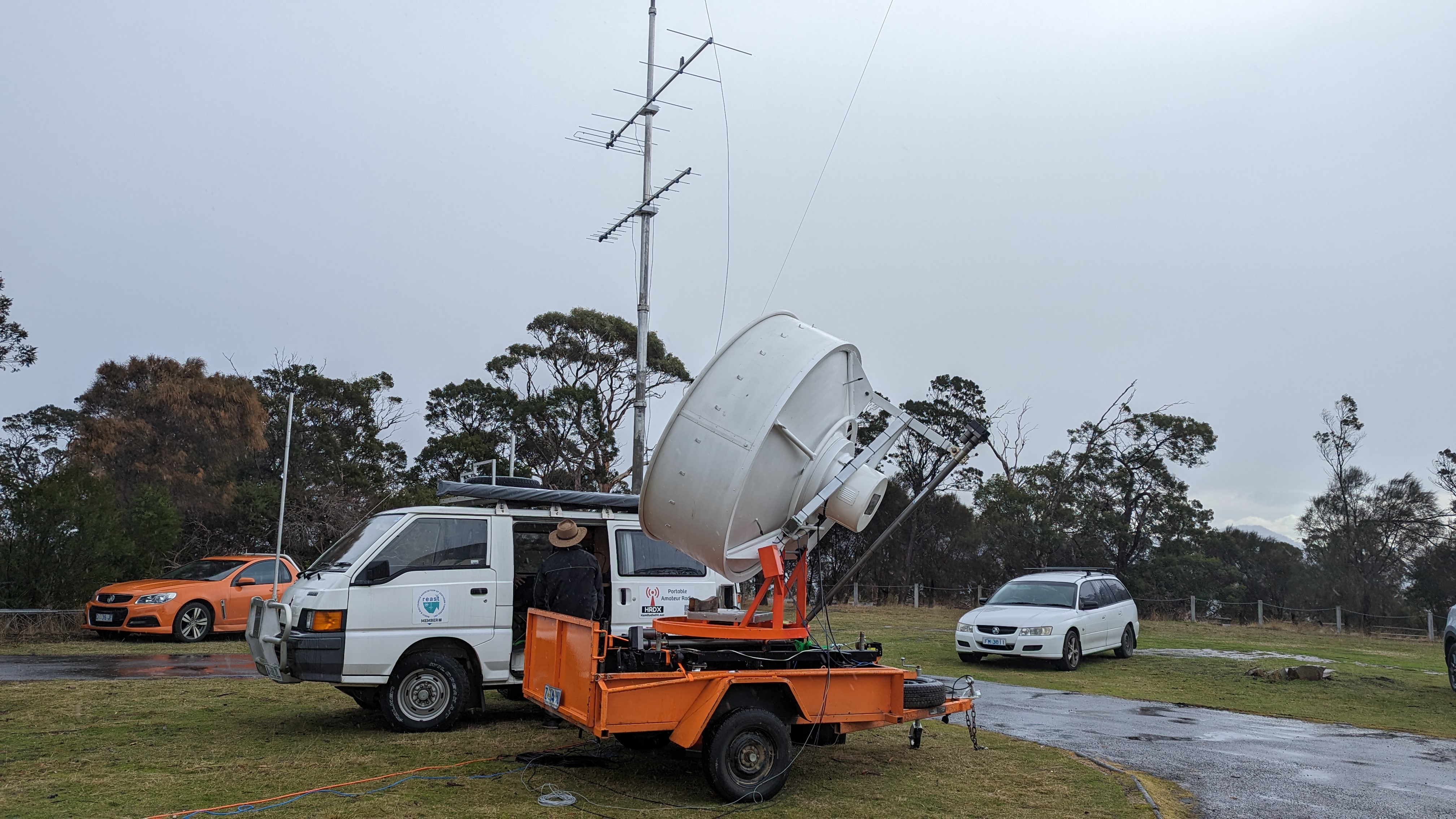 VK7ZBX 3 cm 1.8 m dish at Portable QTH
VK7ZBX 3 cm 1.8 m dish at Portable QTH
W1FKF Don
I am QRV on 1296 MHz with a 2 meter mesh dish, septum feed, WD5AGO preamp, W6PQL amp, and 400 watts at feed. After a year of tweaking I am satisfied with the performance.
I spent some time on 1296 MHz during the ARRL EME Contest and worked 80 stations in 70 Grids and 31 Countries. I worked a few new ones but missed a lot. If anyone on 1296 needs NH FN43gi please contact me.
I am working on 10 GHz with a 1.5 meter offset dish and 40 watts.
 W1FKF Dish
W1FKF Dish
 W1FKF 8 foot offset dish for 10 GHz
W1FKF 8 foot offset dish for 10 GHz
W2HRO Paul
I have been spending my free time working on the new 4.6 m dish at the W2ZQ club station. The club had a good contest, and now I'm catching up on other projects.
At my home station, I'm adding 222 MHz EME to my 4.5 m dish and have 1 kW transmit power. The 2.4 m offset is waiting for a new 30-Watt 10 GHz amp to arrive.
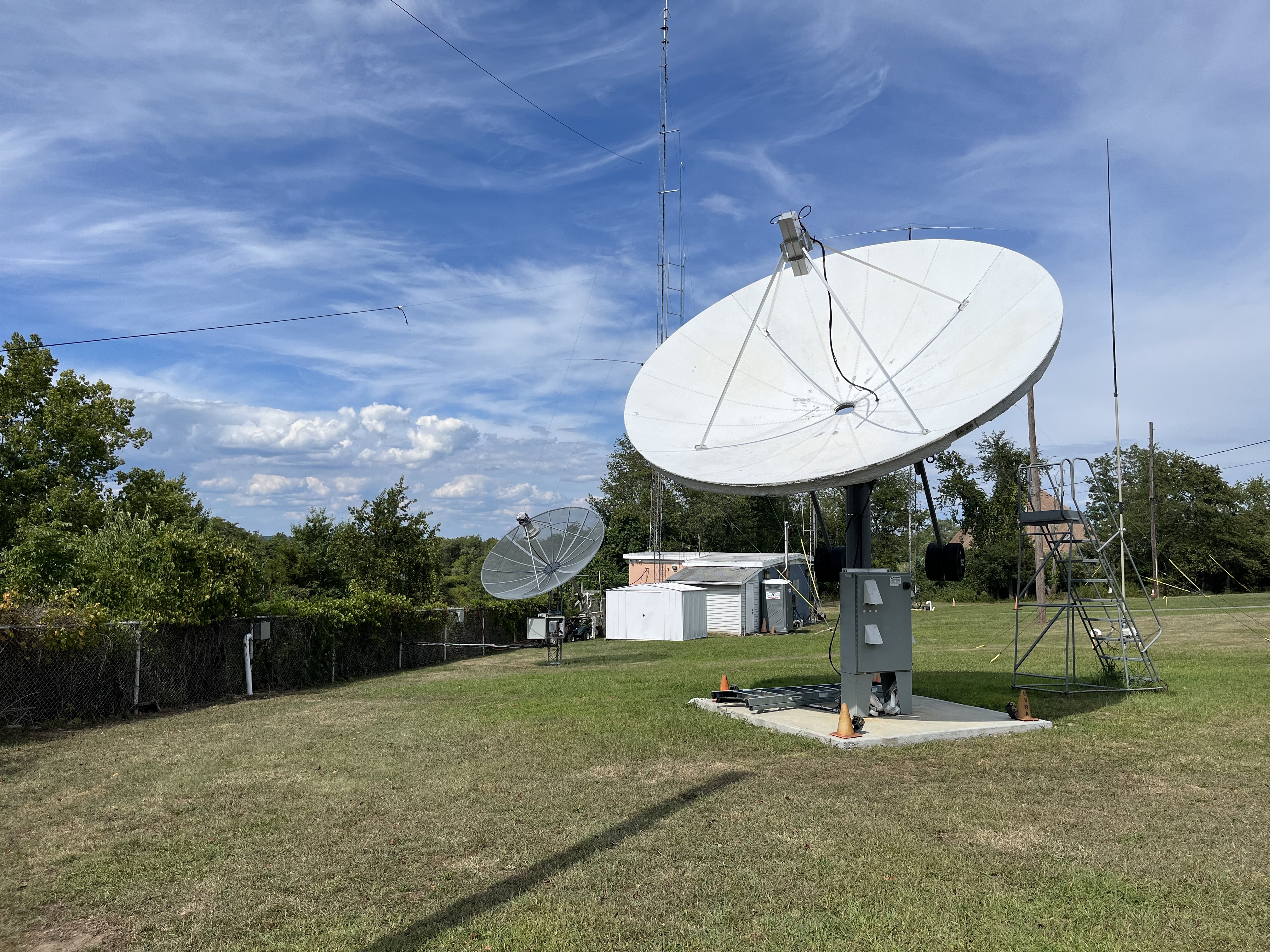 W2HRO W2ZQ dishes
W2HRO W2ZQ dishes
W2LPL Les
I only operated at my home station (W2LPL) for a few hours, as I was privileged to be part of the W2ZQ club station with a talented group of EMErs. At home, I made 35 contacts with a 1.5 M Solar cooker and 300 W.
The high moon Elevation was not ideal for me, as most of the time I was shooting through the canopies of my trees, so mostly I was working the big guns. Contacts were so much faster then in the past with the use of 30B mode, and I even worked Bob KA1GT on 15A mode.
Prior to the contest, I found a 1.5 M Solar cooker, was able to work other solar cookers and of course KB2SA's 1.0 m dish.
I had planned to get on 2 m EME with my 4X2XP9 and a KW, but was having so much fun on 1296 I never got around to it.
W2ZQ DVRA Club
We are W2ZQ (DVRA Club EME Station), a 4th-year participant in the ARRL EME Contest. In the first year, we operated a 3 m dish with 250 watts. This year, we operated our new 4.6 m with 500 watts at the feed. See the picture.
W2ZQ was active on 1296 MHz only. We finished the contest with 165 QSOs, including 9 on CW, and 139 multipliers. Our claimed score is a best ever - 2,293,500. We were happy to see a significant increase in activity from North America. It was great to work so many of our old friends and dozens of new stations, some using solar cookers and folding dishes. Still, there's plenty of room for more stations and more activity! During the November weekend, there were many hours with our QMAP + WSJT-X windows full of decoded traffic, but everyone had already been worked! During the contest, we had a dozen W2ZQ member OPs, some operating EME for the first time ever.
We are already planning improvements for next year's station. The W2ZQ EME Team is led by K1JT, engineered by W2HRO and N2VY, and supported by a strong 200+ member club.
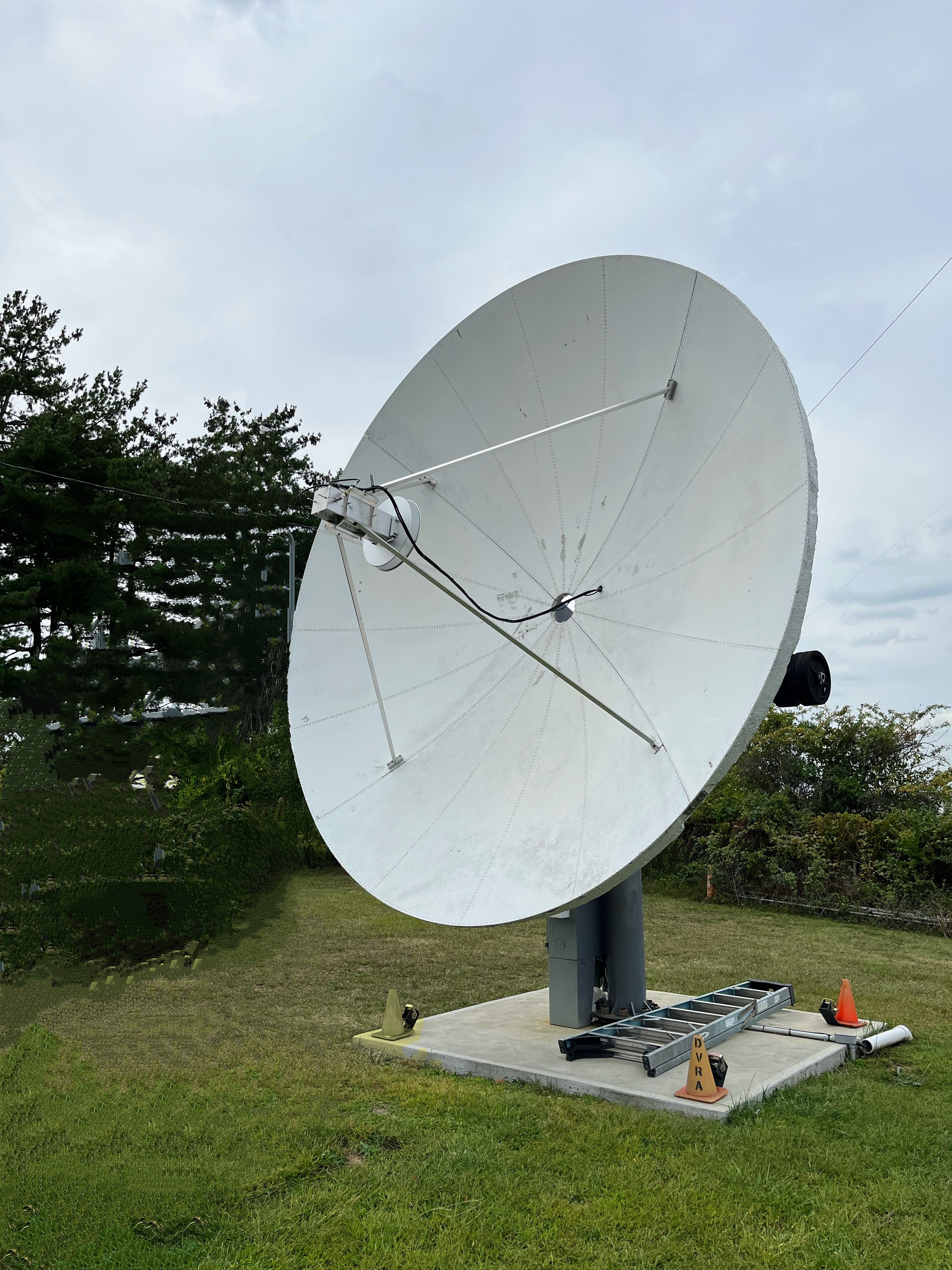 W2ZQ 4.6 m dish
W2ZQ 4.6 m dish
W3TI Andrew
I was only active in October and November for the 2025 ARRL EME Contest.
My first weekend on October 11 & 12 was solid. I used my W2HRO 2.4 m dish and W6PQL amp to make 53 contacts on 1296. The weather was good - no rain and little wind - so it was easy going. On a whim, I threw up a 25el 432 antenna and was able to work NC1I and HB9Q. Naturally, that inspired me to try to get a decent 432 setup ready for the November weekend. After some back and forth with Goran (YU1CF), I ordered 4 antennas and rushed to get it set up for this weekend. With only a few days to spare, I got it done (photo attached).
On Friday November 7 rain prohibited me setting up my dish, so I focused on 432 and walked away with 12 contacts on Nov 8. I heard many other stations but they couldn't hear me - probably a combo of conditions (from what others were saying) and my limited power (150 w at the amp).
On November 9, I was back and forth between the two bands and snagged 39 additional contacts on 23 cm and 6 more on 70 cm.
I even had my 902 feed in for a bit but I need to do some more testing before that's ready for primetime.
Total contest results: 23 cm: 92 QSOs and 70cm: 18 QSOs
Thanks to those who answered my numerous questions over the past year (and week in particular). I'm very happy with my results and looking forward to gearing up for some other bands and improving my results on these in the future.
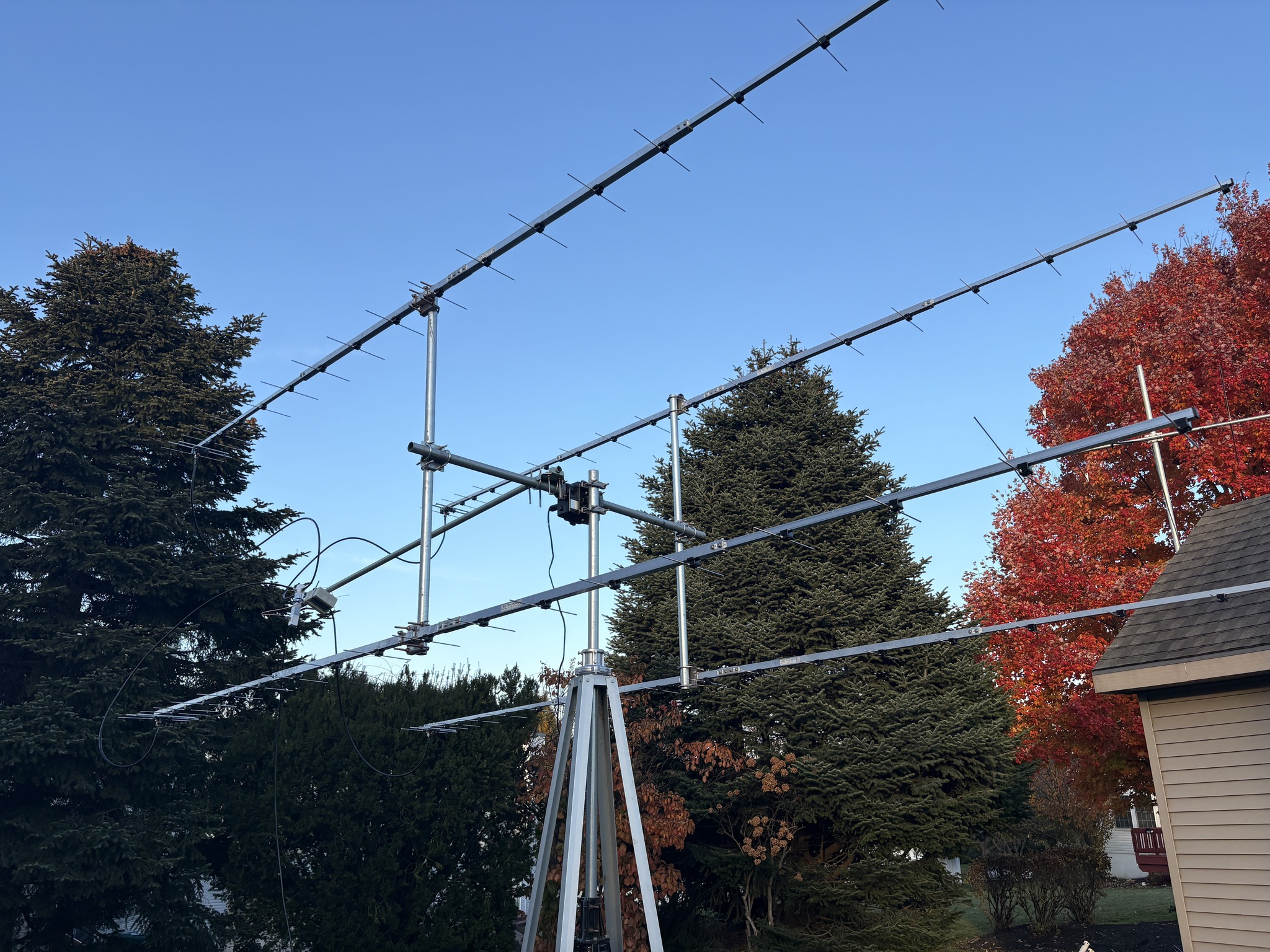 W3TI Antenna
W3TI Antenna
W4OP Dale
Sadly, I am no longer QRV on 23 cm EME after 30 years. Thanks so much for all the wonderful EME QSOs. If anyone is interested in my station, or parts please email me at
For Sale : W4OP Station equipment
Q5 23 cm transverter 25 W version with separate 28 MHz IF
VE4MA scalar feed with the WD5AGO superscalar choke
SM6FHZ septum feed - beautifully constructed
15 foot prime focus ~0.36 F/D
Kuhne solid state amplifier / driver amp, 50 and 12 VDC power supplies. In a water tight PVC enclosure. 220 VAC. Typically 700 W out.
W7CNK LNA box with integral RX probe and SMA relay
W7CNK spare LNA
WA4LM David
After a year of 23 cm EME research, station design, parts gathering, building the SSPA and a dish, my first EME contacts occurred on 2-Aug-2025 with XE1XE, AC2AC and KB2SA. This band and operating mode are completely new to me and have been very exciting. Enough to keep me up late into the night! And then the EME contest weekends happened and I added many new “initials”. The EME shack is separate from my house and the walk out there includes gazing at the moon along the way. It’s like a touchstone to the heady days of the Apollo moonlandings.
The equipment here is fairly plain vanilla with an IC-9700 transceiver with GPSDO, home-brew SSPA based around W6PQL’s 600 w deck, RFhamdesign 2.4 m dish kit with septum feed, AGO VLNA at 0.23 NF, 15 m of LMR-600UF for transmit, LMR-400 for receive, and WSJT-X running on a MacBook. Power at the feed is 350 w and I see 6-8 dB of sun noise. The AZ-EL rotor is a SPID RAS/HR which I manually steer per WSJT’s Astronomical Data.
As of today, I’ve got 141 contacts with 105 stations in 88 grids. It’s just amazing to me to work stations as far east as Kazakhstan, south to South Africa, and west to Japan and Australia.
I’d sure like to be able to run QMAP on the MAC computer by the time the next contest rolls around, so as to be able to know who is where and when!
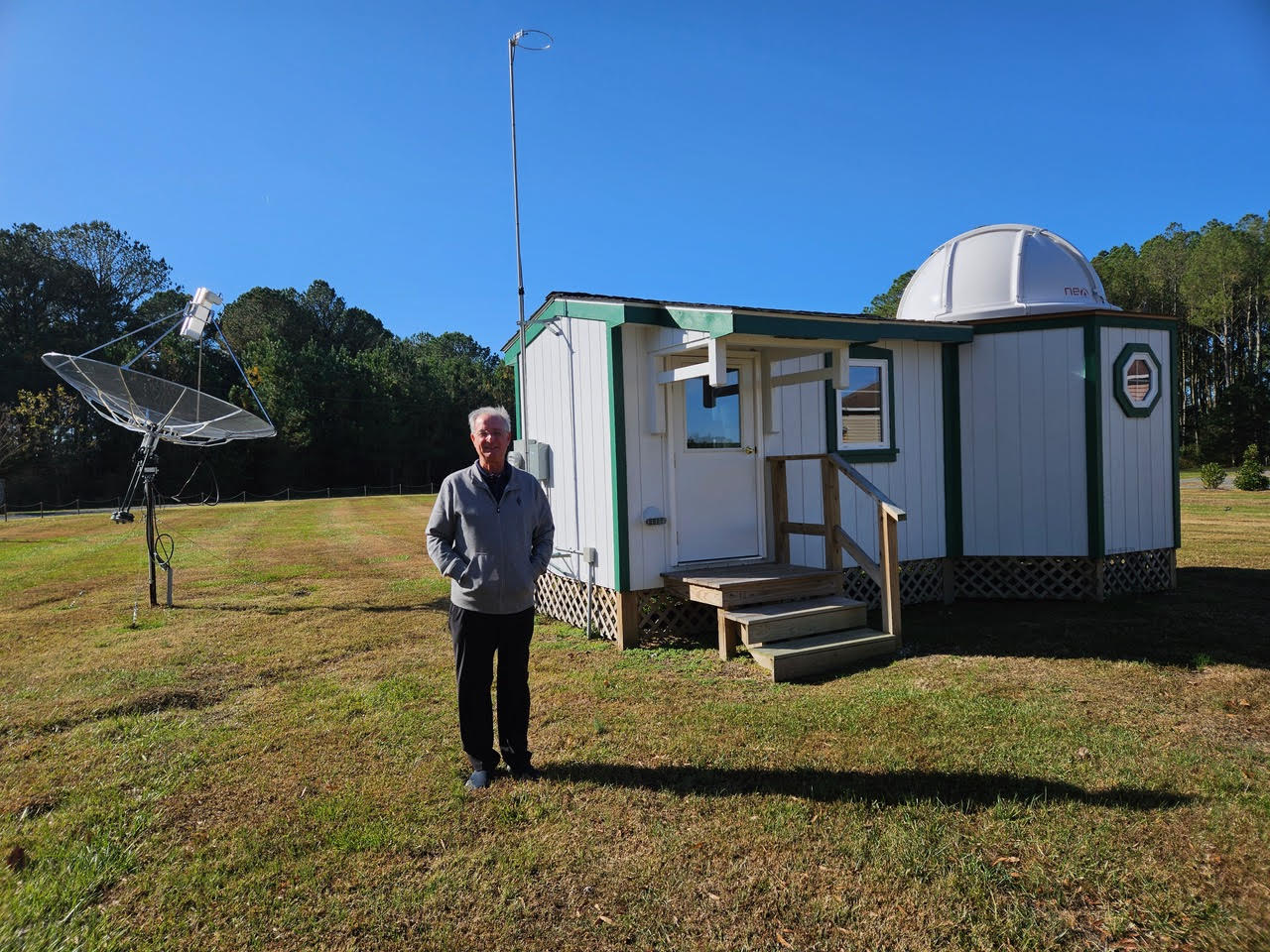 WA4LM Dish and Shack
WA4LM Dish and Shack
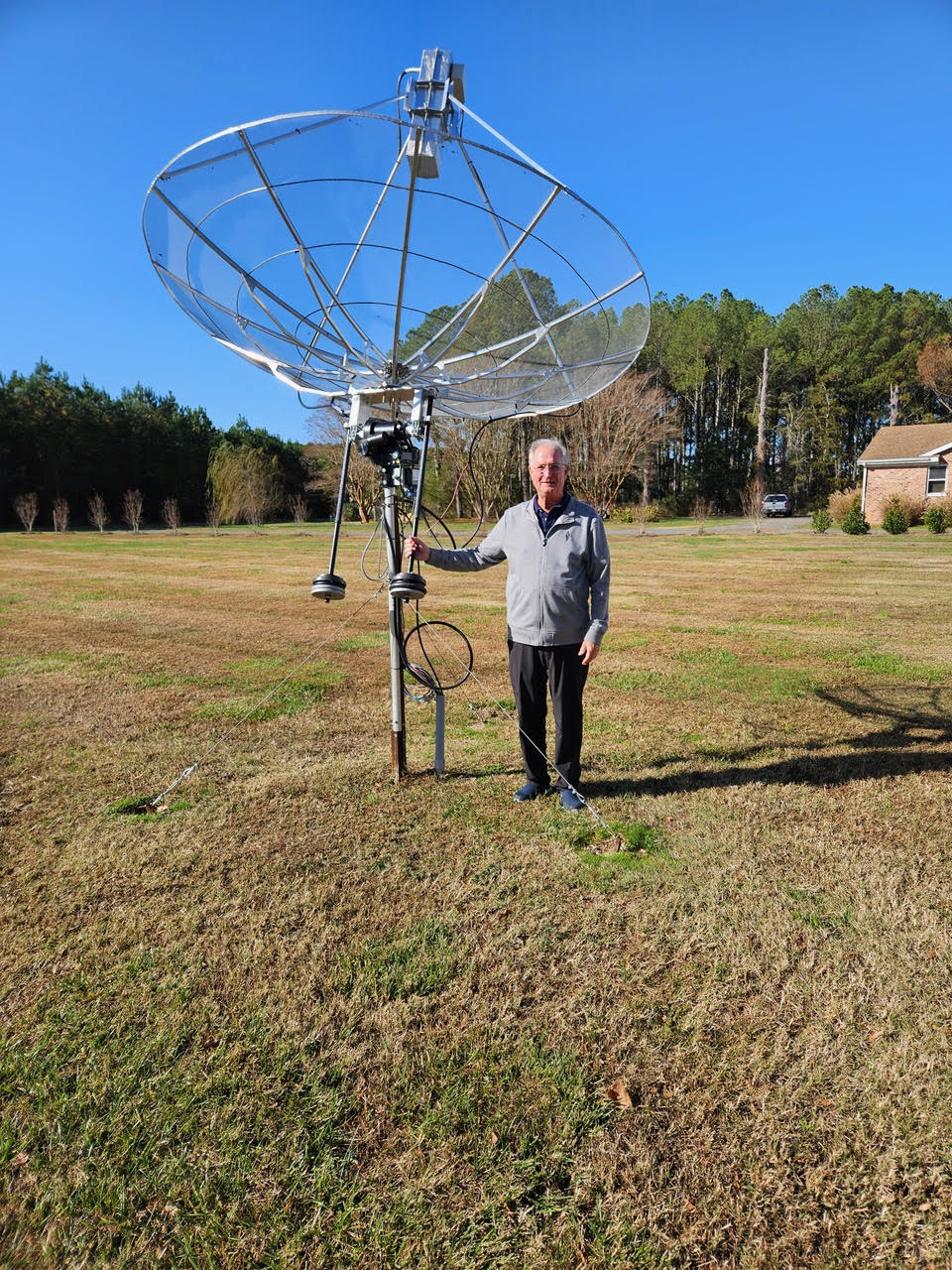 WA4LM Dish close up
WA4LM Dish close up
ARRL EME Contest
The ARRL Radiosport and Regulatory Information Manager, Bart Janke, W9JJ has clarified (in a moon-net post) the desired format for an EME contest submission.
"For each completed QSO, we want to know where (what Grid Square) you operated from and where your QSO Partner operated from - designating in your ADIF or Cabrillo log your 4-Digit-Grid-Square - and your QSO Partner's 4-Digit-Grid-Square.
A (example) cabrillo contest file would look like this:
START-OF-LOG: 3.0
CONTEST: ARRL-EME
CALLSIGN: W9JJ
CATEGORY-OPERATOR: SINGLE-OP
CATEGORY-BAND: ALL
CATEGORY-MODE: MIXED
OPERATORS: W9JJ
QSO: 2.3G CW 2025-08-16 0918 W9JJ FN31 OK1KIR JN79
QSO: 2.3G CW 2025-08-16 0922 W9JJ FN31 OK1DFC JN79
QSO: 3.4G CW 2025-08-16 1121 W9JJ FN31 OE9ERC JN47
QSO: 10G DG 2025-08-16 1322 W9JJ FN31 W2HRO FN20
QSO: 10G DG 2025-08-16 1353 W9JJ FN31 OZ1FF JO45
QSO: 144 DG 2025-09-11 0051 W9JJ FN31 SV3AAF KM17
QSO: 144 DG 2025-10-11 0057 W9JJ FN31 K1DG FN42
END-OF-LOG:
Bruce Horn, WA7BNM, offers a Web Cabrillo formatting tool at https://www.b4h.net/cabforms/arrleme_cab3.php to assist participants.
Again, Grid Squares as multipliers offer more Mults when stations operate from multiple locations. And while ARRL will look at your QSO Partner's upload to see where he/she operated from, using the QRZ address as a fall back is not a 100% indicator of location. When we have the sent and received grid in your uploaded Contest log file, it removes all question for our assigning you the correct multiplier credit count for your efforts.
EME Conference 2026
https://eme2026.moonbounce.info/eme2026.html
The 2026 EME Conference will be in EA8 Tenerife May 28-31, 2026.
Hotel + Travel
Hotel reservations must be made by 31 Jan 2026 and you can call or email the hotel directly.
Additional info regarding travel planning can be found in the August 2025 newsletter:
https://eme.radio/432-and-above-newsletter/432-and-above-2025-08
Pre-registration
Please also contact Rainer EA8DMF at
Presentations
Rainer is also soliciting conference presentations. Please contact him for more information if you have an idea for a presentation or are interested in presenting a session.
CP Axial Ratio Optimisation
DL3WDG Charlie
I have been doing some work to optimise the CP axial ratio of my 1296 system here over the past few weeks. Using the rotating linearly polarised sampling antenna method, similar to that described by W2IMU in Crawford Hills #9, after optimisation I managed to achieve about +/- 0.15 dB (for both RH and LH polarisations) for the feed. I also checked that the axial ratio of the beam from the 2.4 m offset dish was also good using similar measurements in the far field. I hope to publish details of this work in Dubus.
I thought it would then be interesting to measure the difference in SNR of some EME signals between RH and LH CP. This was done using a 5 port relay, that allowed the preamp to be switched from the shack between the RX and TX ports of the feed, while maintaining a 50 ohm load impedance on the other port.
A photo of the system is shown below:
 DL3WDG Test Relay Addition
DL3WDG Test Relay Addition
Using data from the signal report contained in decodes (mainly using QMAP, but also WSJT-X when I needed AP decoding for the weaker stations on the opposite sense), I noticed a considerable variation in the difference for the 22 stations monitored between RH and LH CP, from 16 dB at best, to only 5 dB at worst.
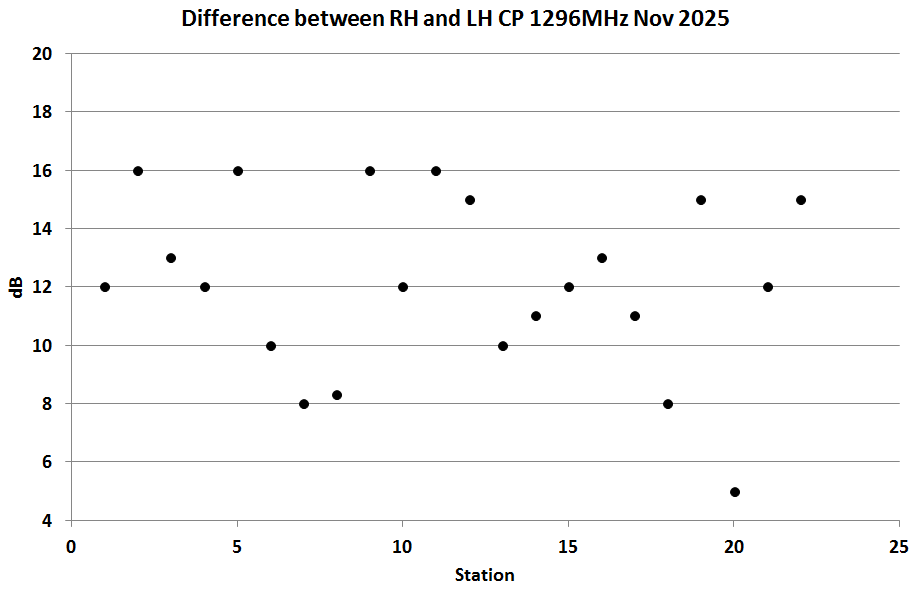 DL3WDG diff between LH RH pol
DL3WDG diff between LH RH pol
Difference between Left Hand and Right Hand Circular Polarisation
The average difference was about 12 dB. This doesn't result in a significant loss in performance when communicating with a station with perfect CP, so is of little concern in most cases. The anomalous result for station #20 was expected, and was caused by a known deficiency in that station's feed. The highest difference of 16 dB seems consistent with the literature, which describes depolarisation occurring at the moon's surface at 23 cm.
Most of this data was collected on Saturday of the last leg of the ARRL EME contest. On Sunday I reconfigured the system to transmit, and worked 47 stations in 5.5 hours. Almost all QSOs were made with Q65-30B, and a few with 15A (which worked well and completes QSOs very fast). QMAP was again extremely useful in finding stations to work.
Murmur 22.0.0
I0NAA Mario
I have released Murmur version 22.0.0 on my website; this update introduces several enhancements to both the radio astronomy module (Pulsar mode) and the System Evaluation module.
New features in the Radio Astronomy (Pulsar mode ) module:
- Predictive detectability analysis for pulsars in the 3 GHz frequency band.
- Automatic retrieval and updating of the ATNF pulsar catalogue.
- SEFD (System Equivalent Flux Density) calculation and evaluation tool, allowing estimation of the expected signal-to-noise ratio for continuous radio sources.
- Noise figures are now available both in dB and in K.
The new SEFD feature is particularly interesting, as it can be used to calibrate the receiving system and optimize performance. It enables precise prediction of the achievable signal-to-noise ratio for very weak cosmic radio sources, based on the selected bandwidth and integration time.
New features in the System Evaluation module:
- A redesigned interface with dynamic controls that allow users to analyze system parameters by simply adjusting sliders.
- Storage of up to three custom station configurations (plus a default profile), enabling rapid recall of settings for different frequencies or antenna setup.
- The Sun Noise Prediction function now supports loading NOAA “previous-day” solar flux data, providing a workaround for the current data availability issues affecting the service.
Although the new “previous-day” solar flux feature is extremely useful, it should be used with caution: due to the current high solar activity, prediction errors may be significant.
Murmur also performs an automatic version check at startup to notify the user if a newer release is available.
The program is downloadable for free from my website: http://i0naa.altervista.org/index.php/downloads
Feedback, including comments, suggestions, or corrections, is highly appreciated!
Dwingeloo - Open Research Institute
Michelle Thompson W5NYV
PI9RD had a visit from Michelle Thompson, W5NYV. Her report can be read on the Open Research Institute site:
https://www.openresearch.institute/2025/11/12/a-day-at-dwingeloo/
DUBUS-REF 2026 Contests
There are two changes from last year, in response to feedback:
- All the dates are Saturdays, except the 23 cm which is a full 48 hour weekend. This change is because its hard on the central Europeans if it finishes at 02:00 Local on Monday local time and they need to be up at 06:00 Local to go to work.
- 24 GHz is a separate date from 10 GHz, last year they were on the same weekend.
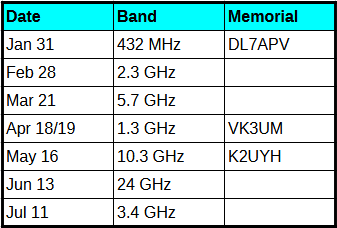 DUBUS REF 2026 EME Contests
DUBUS REF 2026 EME Contests